When the summer full moon struck Manhattan Beach, it could have been forecasting a new and unexpected event, such as a Thai girl not only making a French dessert but blogging about it too 🙂 This is actually not the first time I’m blogging about a French dessert. In fact, my very first blog was for French macarons. This, my 101st blog, will follow the same tradition.
This time it is about Kouign-Amann, the French, or, to be exact, the Breton pastry, that has a name that sounds like it is from the Middle East but is truly French born.
OK…don’t go WTF just yet. Wait until you finish making this, and maybe even better is to wait until after you actually eat them.
Kouign-Amann is pronounced “kween-yah-mann” or “Ku-eeen Aah-man”. No, I didn’t know how to pronounce this from birth, or by birth either. I called Kouign-Amann “the thing” (I know…sorry) or “the Breton crunchy cake” for at the least 2-3 decades. That’s all. Not so long. It’s so difficult to figure out how to pronounce. This time I got my husbanditor-dictionary to give me the correct pronunciation. (Ahhh…good thing I married someone who can read French!)
What is this pastry exactly?
If I use French pastry terminology, I would say this is a “laminated dough with a sugar layer, baked in sugar and butter until the sugar turns into caramel”, but I don’t think there is a pastry chef who doesn’t know Kouign-Amann.
Laminated dough is the term used to describe dough that is wrapped around a block of butter, then rolled out with the butter still in between until thin, and then folded. The butter will eventually divide the dough into several layers. After the first folding, the dough is rolled out and folded several more times and that multiplies the number of layers.
Kouign-Amann uses bread dough and is laminated just like croissant dough except, after the last roll out, the dough would be covered with granulated sugar before folding.
According to many, many pastry cookbooks, Kouign-Amann is a traditional Breton dessert, including the name. Kouign = Cake, Amann = Butter (These are Breton French not French French words). This is considered a butter cake in Brittany. (For those of you geographically challenged, like me, Brittany is the Western-most province of France, closest to England.)
And so it introduced itself to me as a cake the first time we met. I was in England and someone brought this cake back from France as a gift to the hostess. It was big and round just like cake, with the caramelized sugar crust on the top just like creme brûlée, even though the top is quite uneven. Once it got cut, I saw that it was actually not a typical texture of a cake but looked more like a very dense croissant with several layers.
It was actually not that easy to cut with a spoon. It had some resistance and crunchiness, totally unlike cake, and the first bite nearly brought tears to my eyes. How much of my life had been wasted not knowing that this thing existed?! What a shame! The crunchiness was from caramelized sugar melted with butter that was coated on the outside, just like toffee. The texture of the cake was like bread but unlike bread pudding, because that has some kind of custard mixed in. This one is dry and clean but flaky and buttery, so buttery, like the dough has been sitting in a block of butter and had just shaken off the excess in the oven right before it was served.
I know this is going to turn some of you off, thinking it is so not worth it to clog your arteries with it. Well, you are wrong. It’s worth it. (Also, read the new research about heart decease and eating saturated fat.) If I were to die from eating, my wish would be that it was from Kouign-Amann. If my last bite on this earth is Kouign-Amann, I will have died happy.
After my first introduction, I went looking into the history. (Yes, I was THAT curious about food at a young age). It said Yves René Scordia, a baker from Douarnenez in Brittany created it and began selling the pastry in 1860. Some say he was inspired by Norwegian pastry. Some say that he was just attempting to salvage his failed bread dough by adding butter and sugar. But whatever he did, here came a wonderful dessert left behind for us to remember him by, well over hundred years later.
It was a very long time before I attempted to make my own Kouign-Amann. It was intimidating, you know. The laminated dough, the amount of butter used, the SUGAR! Oh my gosh, it was all a little too much to accomplish perfectly, having so little skill in baking as a Thai girl. Back then I didn’t even know how to make a pie crust or bread yet.
Then I was introduced to a little thing called Kouignette, a little tiny Kouign-Amann, about a four-bite size. Ohhhh…this is even BETTER! There is more area to be caramelized and you don’t have to eat a whole wedge of cake anymore. It’s like a cupcake or mini cup cake.
Then I moved to America…phewwwww. You couldn’t even try to find either Kouign-Amann or Kouignette (this is back in 1992) because they were nearly non-existent back then, plus I was living on the allowance of an international graduate student that couldn’t work, so I probably would not have been able to afford it anyway.
I finally found that actually in the US there were some bakeries selling Kouignette, but they were called Kouign-Amann regardless of the size. They didn’t look that appealing and, once the customers found out what was in them, they avoided them. You know how the Americans always eat very sensibly and always eat healthy foods (lol), low-fat, fat-free, low-carb, low-sugar, sugar-free, gluten-free, pretty confusing but all for the health, right? So, Kouign-Amann didn’t fit in any of those categories.
This little dessert is filled with carbs, flour and sugar and fat, real butter (until someone can invent a fat-free butter—come on guys, it shouldn’t be that hard!) The recipe could have freaked the US population out completely. Thank God they haven’t banned the making of this dessert. One of the original bakeries I found in NYC that made this dessert quite well has already closed, Fauchon Bakery on Park Avenue in NYC.
Then a series of bakeries in the metropolitan area slowly embraced this dessert, even though some people still called it the “poison-filled dessert”. Bouchon bakery in Beverly Hills, Dominique Ansel Bakery in Soho (This one is called DKA), McCall’s Meat and Fish Co. in Los Feliz, CA, Bread Lounge in LA, Amandine Patisserie, also in LA and Starter Bakery, the bakery truck in Oakland.
So why am I making them now?
Well, since I’ve recently acquired a new set of skills, thanks to Nantana Chitman, whom I respect dearly as a mentor, who created the online group “C is for Croissant”, and pulled people to start making homemade croissants. I pushed myself through practicing making my own croissants until they come out pretty good these days.
Of course, it was this grand step that made the making of Kouign-Amann quite easy to me. Also, the closet bakery that made Kouign-Amann near my house, Bouchon, is still 15 miles away and could take me 20-40 minutes to get there. And the most important part, no one makes Kouign-Amann exactly the way I wanted. So, I ended up making my own.
What’s the “missing” ingredient in the dessert enough for me to sweat it?
Buckwheat flour!
This is a Breton dessert, and I got used to it with some buckwheat flour in the mix. Also some of those bakeries don’t bake them long enough to make the sugar caramelize, and most of them don’t make it the size I want.
Here we go; let’s start making this dessert. I want it so tiny tiny, about 1”x 1”. My plan is that I can just pop them in my mouth like candies…actually, I want to make them small so I don’t have to eat a whole big piece, because I would if it came that way.
Ingredients:
Organic all purpose flour 250g
(Optional) Buckwheat flour 25g (If you don’t want to use buckwheat flour you need to substitute with 25g more of all purpose flour or whole wheat flour)
Sugar, from 175 – 225g (I used only 175g, but most other recipes would use much more than that. This is entirely your preference. I use less sugar because I don’t want it to be too sweet inside, but I want a lot of caramelized sugar on the outside.)
Water at 90 ºF, from 145 – 172g (I gave this recipe to a friend in Thailand and she reported using less water than the recipe. She didn’t use buckwheat flour and used all 275g of all purpose flour with 140g of water. I used buckwheat flour and use 172g of water. If I used all white flour I would used 160g of water. So adjust it accordingly.)
Salt 7.5g
Fresh yeast 5g or use 2g instant yeast or 2.5g of active dry yeast (I hope you know the different between those yeasts. IMPORTANT: DO NOT USE SOURDOUGH STARTER)
Butter, a block between 150g – 225g (This depends on your laminating skill. I like using 175g of butter the most for myself, but Pierre Hermé uses 225g in his recipe, same as Ladurée)
Extra butter for brushing the mold 10 – 20g (The butter should be soft but not melted)
Method:
1) Mix the flour, salt (make sure it doesn’t touch the yeast directly), buckwheat flour and yeast with a dough hook or by hand. If you are using fresh yeast or active dry yeast, mix it in water and a tablespoon or flour first and see if it foams before mixing it in the dough. You don’t need to do this with instant yeast.
Add the water in small amounts, adding more if the dough needs it. You can tell you need more by the way that the dough won’t combine into one lump but still scatters dry bits all over the mixing bowl.
You don’t need to mix it a lot. Just mix it enough so all the ingredients are combined and form a uniform dough. No need to check for the windowpane. You shouldn’t be able to pass the windowpane test. Just clean in the bowl will be fine. We will be working the dough in many, many more layers. If you mix it until the dough forms gluten enough to pass the windowpane test, you will have a hard time rolling the dough later.
2) Put the dough in a bowl and let it rise to double in size, about 2 hours for me, but it will be different in every house depending on the temperature, humidity, and what type of yeast you are using.
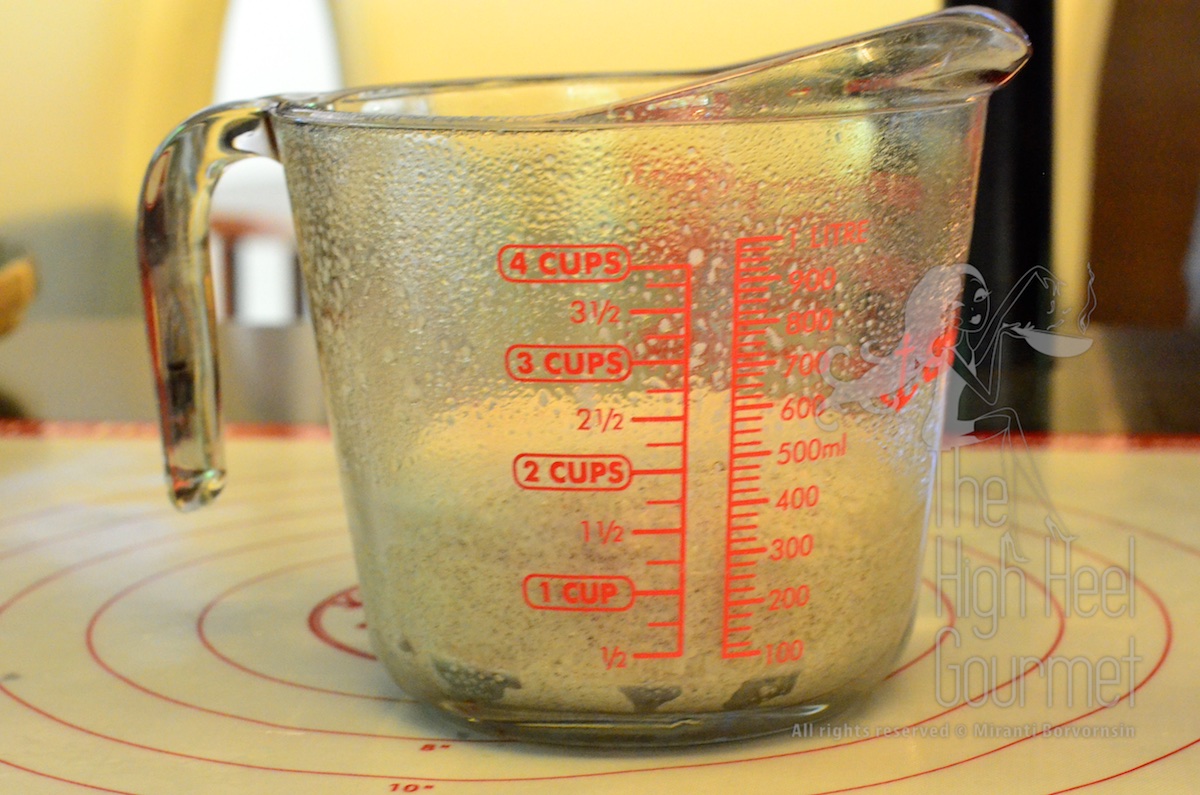
I use a measuring cup so I can see the volume very easily. I sprayed or brushed the surface with oil too.
3) While you are waiting for the dough to rise, pound the butter with a rolling pin until it’s soft.
This is my method. I cut the cold butter to pieces.
Line those pieces together in parchment paper.
Pound the pieces with a rolling pin while still cold to make them soft.
The butter should be “pliable”. Wrap the butter in parchment paper and roll it to fit the size your are working toward. I would recommend 14”x 8” size. Then put the butter in the fridge.
4) Once the dough has doubled in volume, take the dough out, put it on the rolling board and roll it out to a size about 1/3 longer than the length of your butter block, and the same width (21”x 8”). Because the dough is soft, if you can’t roll and get a straight edge, you can use just push the edge of the dough to the shape you want.
5) Take the butter block out of the fridge and roll the rolling pin over the butter block again one more time until it is back to the pliable stage again.
6) Place the butter to cover 2/3 of the dough on one side, leaving 1/3 uncovered. Line the butter block along one side of the dough. Make sure that the top and bottom edge of the butter isn’t beyond the edge of the dough.
7) Fold the uncovered side over the middle onto the butter block. If you roll the dough to the width I recommend, you shouldn’t have any problem folding from edge to edge.
8) Fold the other buttered side carefully over the middle. This is called “the envelope fold.” Make sure that the dough reaches from edge to edge.
9) Wrap the whole block in plastic and put it in the refrigerator for 30 minutes.
10) Take the dough out, dust it with flour, then brush the excess flour off. The dough should be rolled out along the length of the dough block. This is called “turning the dough”. The direction of the rolling is going to be 90 degrees from the first direction.
Press the dough carefully to stretch the dough first before rolling, to maintain the layers.
Roll the dough out to 21”x 8” again, and then do the envelope fold again.
11) Chill the dough again for another 30 minutes.
12) Measure the sugar and put it in a bowl now. You will need it for the next step. I didn’t measure exactly how much sugar I used in the dough itself versus in the molds, but it was about 2/3 or 3/4 of the total amount I used (175g). In other words, much more sugar in the dough than what I sprinkled in the molds.
13) Take the dough out off the fridge and roll it again to the same full size. This time you sprinkle the bottom of the rolling board with a little bit of sugar.
Once you’ve rolled the dough out, then you sprinkle much more sugar on the dough. Look at the picture to see what I mean by “much more.” Pretty much covered the whole dough with sugar. That much more.
14) Roll the rolling pin over the sugar just to press the sugar down into the dough before you fold the dough. Do one more envelope fold, wrap it and put it back in the fridge.
15) Chill the dough for another 30 minutes.
16) While you are waiting, let’s prep the mold. Butter all sides of the individual molds,
and start drizzling the sugar in to the molds.
Make sure that the sugar is sticking to the butter all around the individual molds. See NOTE#1 about the proper size.
17) Take the dough out of the fridge. Be very careful; the dough is going to be slightly wet because the sugar will melt a little, so handle it extremely delicately.
18) Roll the dough back to full size, or until the thickness of the dough reaches 1/4”.
19) Cut the dough to the proper size to the mold. See NOTE #1 for the proper size.
20) Fold all corners of the dough to the middle and put the dough in the molds.
21) Let the dough proof for another hour or so until the dough increases its volume by 1/3 or 1/2.
22) Bake at 350ºF 15-20 minutes for the tiny brownie molds, 20-25 minutes for the mini-muffin molds. You will need at the least 20-25 minutes to caramelize the sugar properly.
24) IMPORTANT: Take them out of the molds while still hot or you will have fun digging crumbs of toffee and dough out of the molds. This is caramel; it doesn’t really change it sticky property just because there is dough stuck to it, alright? So, be quick and take the Kouignettes out of the molds as soon as they come out of the oven.
25) Do I need to tell you this part?
NOW EAT THEM!
NOTE:
1) I’m using a mini-muffin tin for the 2”x2” size and I have a little tiny molds for the micro size muffin, about 1.25”x1.25” brownie bite molds. I would recommend mini-muffin the first time around because the result is closer to the Kouign-Amann or Kouignette sold in the market.
The tiny brownie molds would give you either too dark and crunchy Kouignettes or not be caramelized enough because of the size. If you bake until the sugar caramelizes properly the inside will already be too dry. You won’t get the soft inside texture with the 2” x 2” size, but you would get the perfect crunchiness on the outside with soft texture on the inside.
If you want a bigger one, you can do it the way famous bakeries do by cutting the dough to a 3”x 3” or 4”x 4” size, depending on your pastry ring (1” high) size. Butter the tray and drizzle with sugar same as the ring and place the ring on top of the tray.
Can you see how many layers of dough we are making here?
Don’t worry about the rest of this, unless you can read it. It’s in Thai for my Thai followers.
ขนมอร่อยสุดๆของฝรั่งเศสอีกอย่าง เอามาแนะนำให้รู้จักกันไว้ ขนมชนิดนี้ไม่ซับซ้อนตรงเครื่องปรุง แต่ซับซ้อนนิดหน่อยในการทำ ก็สไตล์เดียวกับขนมฝรั่งเศสทั้งหลาย ไม่ถึก ไม่อึด ไม่เนี้ยบ ก็ทำได้แต่จะออกมาไม่ค่อยดี ก็ทำคุ้กกี้ เค้ก บราวนี่ไปก่อน อย่าเพิ่งคิดจะลองเจ้านี่ เดี๋ยวจะนึกว่าตัวเองไม่เก่ง จิตตกเปล่าๆ ขนมชนิดนี้ไม่ต้องใช้ฝีมือระดับครัวซองต์แต่มีก็ดี
Kouign-Amann ออกเสียงว่า “ควีนอามัน” หรือ “คูอีนน-อามัน” อย่าอ่านทีละคำเชียว จะไม่เข้าใจว่าพูดถึงเรื่องเดียวกัน
อันนี้เป็นขนมของพวกบรีตอง ซึ่งอยู่ในแค้วนบรีตานีของฝรั่งเศส พวกนี้เขามีภาษาพูดของเขาเองที่ไม่ใช่ภาษาฝรั่งเศส Kouign ในภาษาเขาแปลว่าเค้ก Amann แปลว่าเนย ขนมนี้ก็คือ เค้กเนยของบรีตองนั่นเอง
การทำขนมชนิดนี้ต้องใช้ทักษะในการรีดหรือฝรั่งเรียกว่าการลามิเนต Laminate เพราะเป็นแป้งชั้น ค่อยๆดูตามรูปข้างบนไป แป้งที่นำมาทำเป็นแป้งที่มียีสต์เช่นเดียวกับแป้งครัวซองต์ จึงต้องมีการพรูฟให้แป้งขึ้นด้วย
อย่างแรกคือการผสมแป้ง
ส่วนผสม
แป้งอเนกประสงค์ 250g (ใครอยากใช้แป้งเค้ก หรือแป้งขนมปังก็เชิญตามสะดวก texture จะต่างกันเล็กน้อยไม่มาก)
แป้งบัควีท 25g (ถ้าหาไม่ได้ใช้แป้งโฮลวีท หรือแป้งขาวแทนได้ แต่แป้งบัควีทจะเป็นแป้งที่ชาวบริตองใช้กันในขนมอบ ขนมปังหลายอย่าง แม้แต่ในเครปจึงถือว่าเป็นต้นตำรับ)
น้ำอุ่นๆ 140 – 172g (เริ่มที่ 145g ก่อน แล้วดูเอาว่าแป้งแห้งไปหรือเปล่าแล้วค่อยเติมน้ำเพิ่มทีละนิด เราใส่น้ำแค่พอให้โดจับตัวเป็นก้อน น้ำมากเกินไปแป้งจะยานเหมือนนมสาววัยเก้าสิบ น้ำน้อยเกินไปแป้งก็จะเหนียวเหมือนอึนายทุน จะรีดยากมาก หากใช้แป้งโฮลวีทหรือบัควีทจะใช้น้ำมากกว่าใช้แป้งขาว ถ้าใช้แป้งขาวทั้งหมดไม่ควรใส่น้ำเกิน 160g ระวังด้วยว่าเมืองไทยแป้งจะชื้น สูตรนี้ทำในรัฐแคลิฟอร์เนียซึ่งอากาศแห้งพอสมควร เพราะฉะนั้นอย่าได้รีบร้อนเทน้ำพรวดเดียว เดี๋ยวจะพลาดแบบกลับตัวไม่ทัน)
ยีสต์สด 5g (ถ้าจะใช้ยีสต์แห้งแบบ instant ใช้แค่ 2g, ยีสต์แห้งแบบ active dry yeast ใช้ 2.5g ถ้าไม่รู้ว่ายีสต์สามชนิดนี้ต่างกันยังไง ลองไปหาอ่านดู แต่แนะนำว่าในกรณีนี้ให้ลองซ้อมทำขนมปังอย่างอื่นสักสองสามรอบ ก่อนจะลงมือลุยกับควีนอามัน)
เกลือ 7.5g
น้ำตาล 175 – 225g (ลองหนแรกใช้ 225g เลยก็ได้ แล้วค่อยลดถ้าไม่ชอบหรือเห็นว่าหวานไป แบ่งน้ำตาลเป็นสองส่วน ส่วนแรก 3/4 ของน้ำตาลทั้งหมด อีกส่วนก็ 1/4)
เนย 150 – 225g (อันนี้แล้วแต่ฝีมือรีด มือใหม่ใช้เยอะไว้ก่อนจะรีดง่ายกว่า ขนมนี้อร่อยไม่อร่อย หอมไม่หอมขึ้นอยู่กับเนยเป็นสำคัญ ได้ข่าวว่าเมืองไทยเขาใช้เนยที่ผสมไขมันปาล์มกันเป็นปกติ อยากจะบอกว่าไม่เอานะ แต่จริงๆก็ใช้ได้ เพียงแต่ใช้เนยดีๆมันก็ยิ่งอร่อยนะ หาเนยให้ดีที่สุดเท่าที่กระเป๋าเราจะอำนวยแล้วกัน)
เนยทาพิมพ์ 10 – 20g
วิธีทำ (รูปดูจากด้านบนเทียบข้อกันได้เลย ภาษาไทยนี่เป็นลูกเมียน้อย ไม่ค่อยนิยมเขียนเพราะกฎหมายลิขสิทธิ์บ้านเรา เหมือนกติกาเด็กเล่นขายของ ตามเอาผิดกับพวกหน้าไม่อายตู่ขโมยของเขาแทบไม่ได้เลย)
1) ผสมแป้ง, ยีสต์, เกลือ, น้ำ เข้าด้วยกัน ระวังอย่าให้ยีสต์สัมผัสเกลือโดยตรง ยีสต์สด และ active dry yeast จะต้องใส่ลงไปในน้ำอุ่นผสมแป้งแล้วรอจนมีฟองก่อนใช้ เพื่อจะปลุกยีสต์ก่อน ถ้าเป็น instant yeast ใส่ได้เลย
ผสมจนรวมเป็นเนื้อเดียวกันก็พอ ไม่ต้องขึงฟิลม์ เดี๋ยวเราต้องรีดต้องพับ ผสมมากจะรีดยาก
2) ผสมเสร็จก็ต้องรอพรูฟก่อน พรูฟให้ขึ้นสองเท่า
3) ระหว่างนั้นก็ทำบล็อกเนย นวดเนยจนนุ่มด้วยไม้นวดแป้งก่อน แล้วห่อด้วยกระดาษไข พับให้ได้ขนาดที่ต้องการ แนะนำว่าประมาณ 8 นิ้ว x 14 นิ้ว แล้วรีด จนเนยกระจายหนาเท่าๆกันในกระดาษไขที่พับให้ได้ขนาดแล้ว เอาเข้าไปเก็บในตู้เย็น
หมายเหตุ: ใครอยากใช้วิธีตัดเนยเป็นก้อนๆ แล้วโยนๆลงไปก่อนเอาแป้งห่อแล้วรีด ก็ตามสะดวก ฝีมือเจ้าของ blog นี้ไม่ระดับนั้น ถ้าไม่มี butter block จะรีดไม่ได้ชั้นสวยๆ เคยเห็นพวกโปรเขาทำกัน แต่นั่นเขาเก่ง เรามันมือประถมไม่กล้าทำตาม
4) เมื่อแป้งพรูฟได้สองเท่าแล้ว เทออกมาวางบนกระดานรีดเลย เอาแป้งนวลโรยๆเสียก่อน อย่าเยอะ เอาแค่พอไม่ติดกระดาน รีดออกมาให้ได้ขนาด 8 นิ้วนิดๆ x 21 นิ้ว
5) เอาเนยออกมาจากตู้เย็น แล้วรีดทับอีกทีเพื่อให้เนยนุ่มลง เนยกับแป้งต้องมีความนุ่มพอๆกัน แต่เนยต้องเย็น ละลายเหลวเป๋วเป็นอึเด็กเนี่ยรีบเอากลับเข้าตู้ทันที
6) พอรีดซ้ำจนได้เนยที่นุ่มและมีความยืดหยุ่น สามารถพับได้แล้วก็ เอาลงไปแปะลงในแป้งที่รีดไว้แล้ว จากปลายด้านหนึ่ง มา 2/3 ของความยาว (ก็มันทำมาแค่นั้น ใครแปะได้ยาวกว่านั้นก็มหาเทพแล้วล่ะ) ทิ้งอีกปลายไว้เปลือยๆ ไม่มีเนย
7) พับด้านเปลือยลงมาทับตรงกลางแผ่นโด ทับเนยนั่นแหละ
8) คราวนี้พับอีกหาง ด้านที่มีเนยข้างบนนั่นแหละ ทับลงไปบนหางอันแรกที่เพิ่งพับเข้ามา พับแบบนี้เขาเรียกกันว่า พับซองจดหมาย
9) เอาพลาสติกห่อ แล้วเอาเข้าตู้เย็น 30 นาที
10) พอได้เวลาก็เอาแป้งออกมา เอาแป้งนวลโรยอีก คราวนี้โรยแล้วปัดแป้งออก ราวกับว่าแป้งนี้เป็นหน้าเรา ผัดหน้าทาแป้งตอนเช้าๆ ไม่อยากให้มันเป็นจ้ำๆ ก็ทานวลแป้งให้สวยผ่องอย่างนั้น แต่อย่าพิรี้พิไร รีบๆเข้า อากาศเมืองไทยร้อนระเบิด เนยจะละลายเสียก่อน
เอ้า…รีดดดดดด…แต่อย่าเพิ่งทะเล่อทะล่า จับไม้นวดแป้งได้ก็รีดซะยืดดดด ชั้นมันจะเสีย เพราะเนยทะลัก เอาไม้นวดแป้งกด ย้ำๆไปเป็นช่วงๆ ทำแบบนี้เนยจะได้อยู่เย็นเป็นสุข ไม่ทะลักทะลาย แป้งจะได้ไม่ฉีกด้วย กดๆย้ำๆ แล้วค่อยรีดให้ยาวออกมาเท่าเดิม 8 นิ้ว x 21 นิ้ว แล้วพับซองจดหมายอีกที
อ้อ…รีดตามยาวนะ (ดูรูปด้านบน) มันจะเป็นแนวตั้งฉากกับแนวรีดเดิมที่เรารีดหนแรก
11) เอาพลาสติกชิ้นเดิมแหละห่อ อย่าทิ้งเป็นขยะ พลาสติกมันอายุยืน เราซี้แหงเหลือแต่กระดูกแล้วพลาสติกอาจจะยังปลิวดี๊ด๊าอยู่ได้เลย ห่อเสร็จก็เข้าตู้อีกอย่างเดิม ครึ่งชั่วโมง
12) ชั่งน้ำตาลได้แล้ว น้ำตาลนี้จะใช้ส่วนใหญ่ในแป้งในขั้นตอนถัดไป แต่ส่วนน้อยจะเอาไว้ใช้โรยพิมพ์ แบ่งส่วนเอาไว้ให้ดี
13) เอาแป้งออกมาแล้วก็รีดนาทาเร้นกันต่อ ก่อนรีด อย่าลืมแป้งนวล และคราวนี้โรยน้ำตาลลงไปบนบอร์ดด้วยบางๆ รีดหนนี้เกือบจะสุดท้ายแล้ว รีดให้ได้ขนาดเดิม แล้วโรยน้ำตาลให้ทั่ว อย่างเยอะเลย มองแทบไม่เห็นแป้ง
14) กลิ้งไม้นวดแป้งบนน้ำตาลเสียหน่อย ให้น้ำตาลติดกับแป้ง ไม่งั้นพับแล้วจะหล่นมากกองตามรอยพับ หวานจัดๆกันตามซอกตามหลืบ ไม่ยุติธรรม เกลี่ยให้น้ำตาลมันเสมอๆกันแล้วพับซองกันอีกรอบ
15) ห่อพลาสติก เข้าตู้เย็นอีกครึ่งชั่วโมง
16) ระหว่างรอก็เตรียมพิมพ์ ทาเนยให้ทั่วๆ แล้วโรยน้ำตาลทับ เนยจะทำให้น้ำตาลติดพิมพ์ได้ดี การเตรียมพิมพ์นี่สำคัญมากๆ ขนมจะกรอบมีคาราเมลเคลือบทั่วไม่ทั่วก็ชี้ชะตากันตรงนี้เอง อย่าขี้เหนียวเนย อย่างกน้ำตาล กลัวอ้วนอย่าทำ ขนมนี้แคลอรี่ต่อชิ้นน่ากลัวสุดๆ(ประมาณ 90 แคลอรี่ต่อชิ้นขนาดสองคำ) กินวันละสามสี่ชิ้นก็มากแล้ว
หมายเหตุ: จะใช้พิมพ์ขนาดไหนดี แนะนำว่า 2 นิ้ว x 2 นิ้ว จะดีที่สุด เพราะพิมพ์เล็กกว่านั้นมันสุกเร็วไป น้ำตาลยังไม่คาราเมลเลย ขนมสุกแล้ว จะอบจนน้ำตาลคาราเมลเลยขนมก็แทบไหม้ เพราะน้ำตาลจะคาราเมลที่อุณหภูมิ 350 ºF นี่ต้องอบอย่างน้อยๆ 20 นาที แต่อบนานขนาดนั้นขนมชิ้นจิ๋วๆจะกรอบกร้วมทั้งชิ้นเลย ก็อร่อยไปอีกแบบนะจะว่าไป แต่หนแรกเอาขนาดที่ว่าก่อน จะได้รู้ว่าของจริงเขาเป็นยังไง ที่เหลือก็ตัวใครตัวมัน
17) เอาแป้งออกมา หนนี้ต้องระวังการติดกระดานให้มากๆ น้ำตาลมันเจอน้ำในแป้ง มันก็ละลายน่ะสิ ทำให้แป้งเราเริ่มยานเป็นนมคุณยาย แถมติดหนุบติดหนับเสียอีก โรยแป้งนวลบนแป้งแล้วโรยบนโต๊ะด้วย
18) รีดอีกให้บางประมาณ 1/4 นิ้ว หรือครึ่งเซ็นต์
19) ตัดแป้งให้ได้ขนาด 2 1/2 นิ้ว x 2 1/2 นิ้ว
20) พับมุมทั้งสี่เข้ามาชนกันตรงกลาง แล้วใส่ลงไปในพิมพ์ จับจีบๆเสียหน่อยเหมือนทำทองหยิบสี่กลีบ
21) พรูฟจนแป้งฟูขึ้นมาสัก 1/3 หรือเท่าครึ่งก็ได้
22) อุ่นเตาอบ 350ºF พอเตาได้อุณหภูมิแล้ว อบ 20 – 25 นาที
23) ขั้นตอนสำคัญ: เอาออกมาจากเตาอบแล้ว รีบดึงขึ้นจากพิมพ์ทันที น้ำตาลละลายเป็นคาราเมลขนาดนั้น มันเปลี่ยนสภาพเป็นกาวชั้นดี ถ้าไม่รีบตอนนี้ ตอนจะกินก็ต้องงัดกันบ้างล่ะ เพราะกาวมันจะแห้งทำให้ขนมติดพิมพ์น่ะซิ
ใครตอบได้บ้างว่าขนมควีนอามันนี่มีกี่ชั้น
ข้อความและรูปภาพ จดลิขสิทธิ์ ใครคิดจะขโมยทั้งรูปและข้อความเพื่อนำไปเผยแพร่หารายได้เข้าตัว ขอให้ผัวซ้อม เมียทิ้ง เป็นมะเร็งตับ มีลูกขอให้มันเนรคุณสมกับบุพการีที่ไม่มีหิริโอตัปปะ blog นี้เขียนเป็นวิทยาทานให้กับทุกคน อย่าได้คิดคัดลอกนำไปเบียดเบียนหากำไรจากผู้อื่น แต่ถ้าจะเอาวิชาไปทำขนมขายเชิญตามสบายค่ะ ใช้ของดีๆทำนะคะ
ผู้ที่อยากได้ภาพและวิธีทำไปแจกหรือสอนเป็นวิทยาทาน(แปลว่าสอนฟรีไม่ได้คิดค่าเรียน) เชิญติดต่อมาทางอีเมล์พร้อมรายละเอียดได้ค่ะ แต่ผู้ที่จะเปิดคลาสสอน(แปลว่าคิดตังคนมาเรียน)ลองอ่าน แล้วไปหัดทำดูก่อน ทำสักสามสี่ครั้งเป็นอย่างต่ำๆนะคะจะได้รู้ปัญหา และวิธีแก้ปัญหา นักเรียนถามจะได้ไม่ต้องยืนแทะเล็บบิดไปบิดมา ทำแล้วก็เขียนตำราเองจากประสบการณ์เสียเลยจะดีกว่ามาลอกของอิฉันนะ บ่องตง

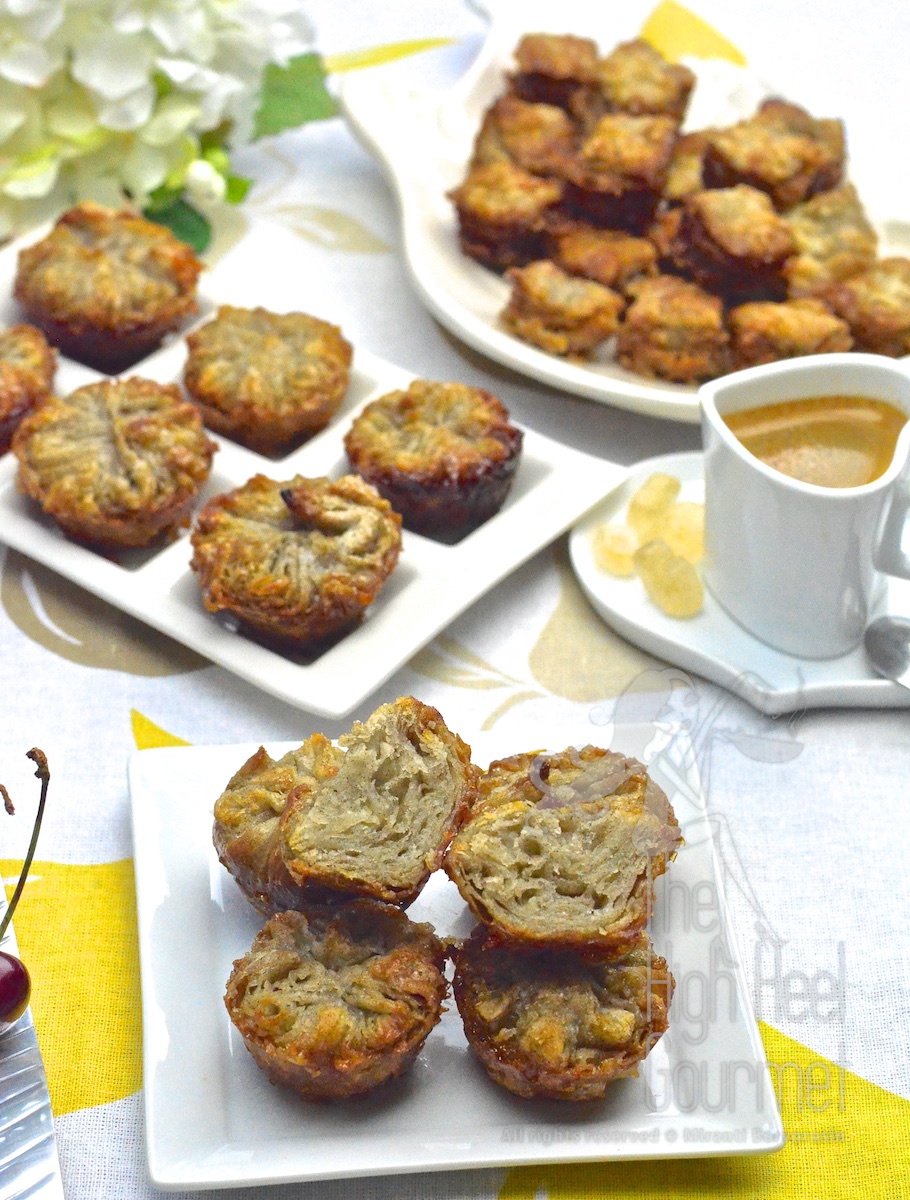
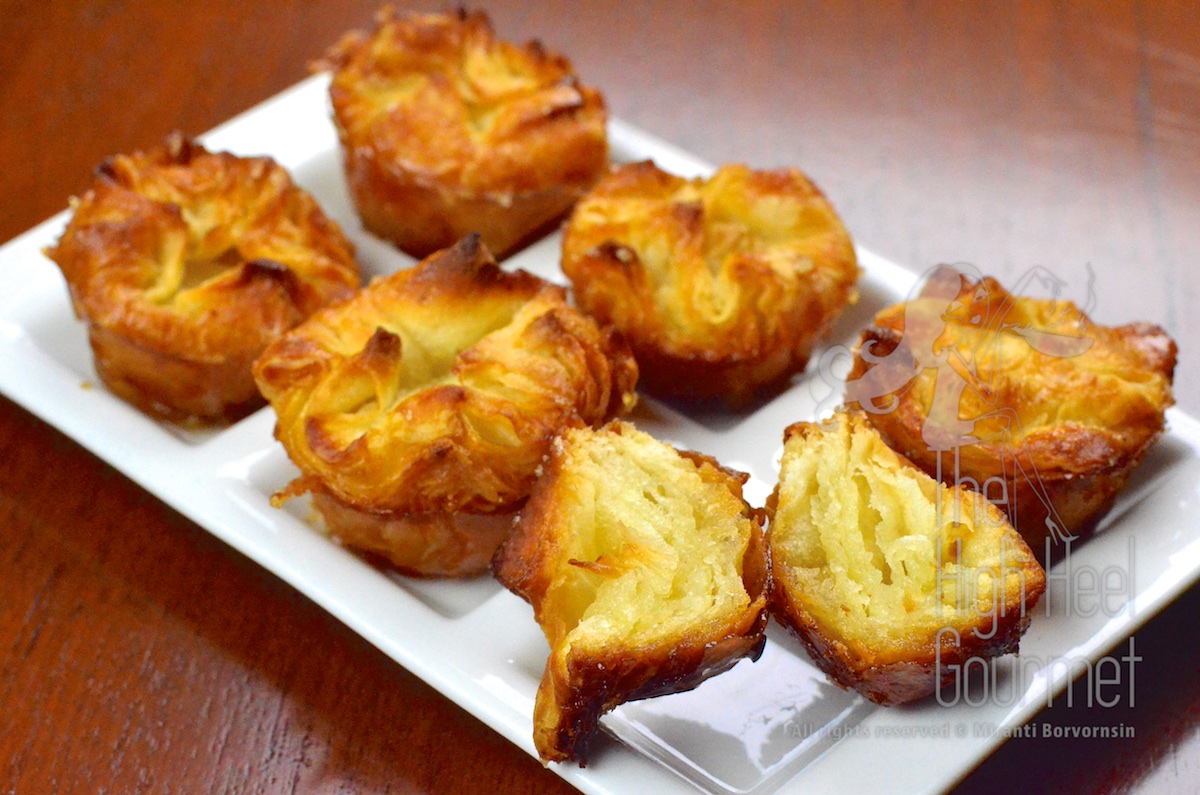
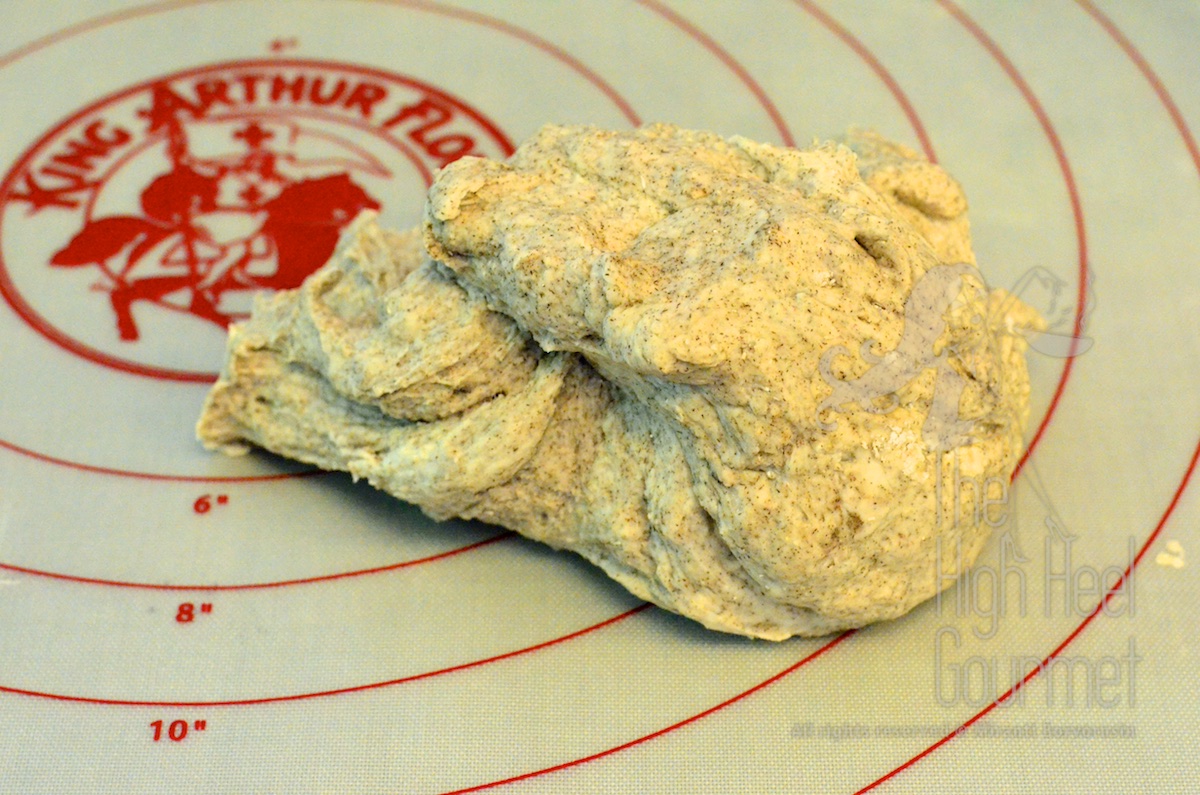
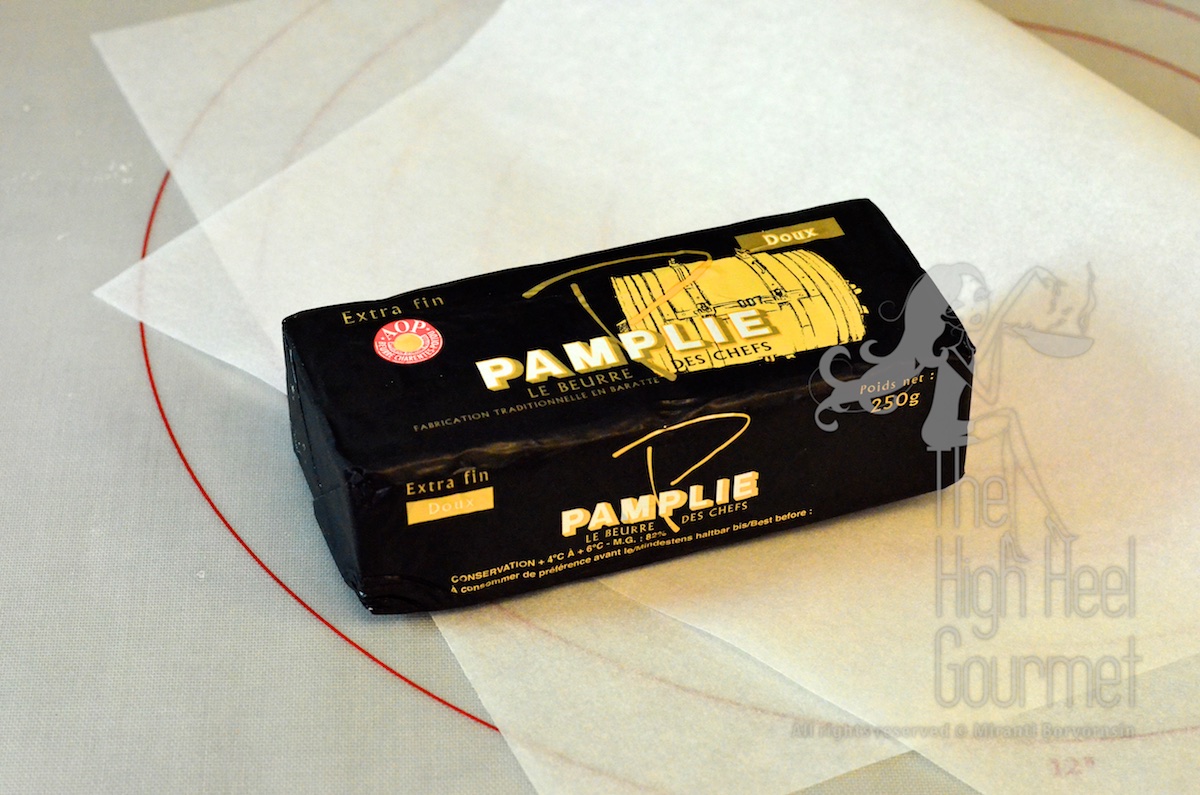
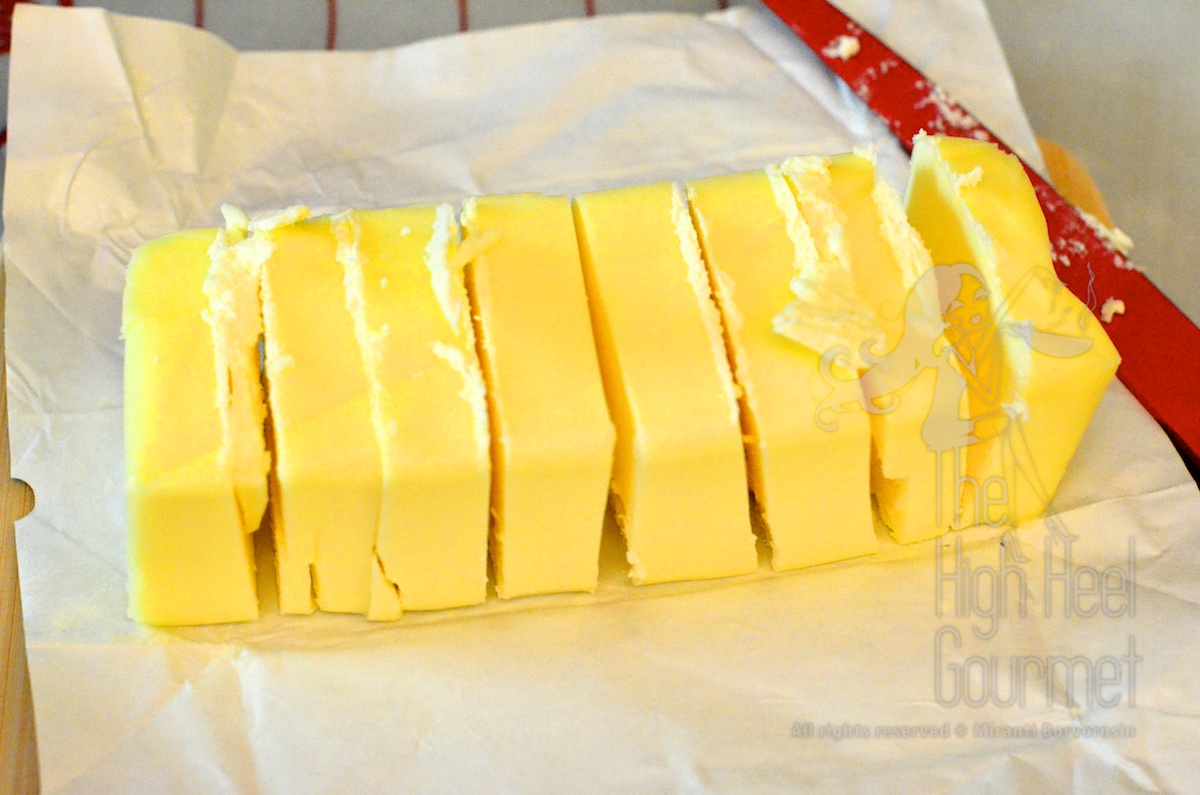
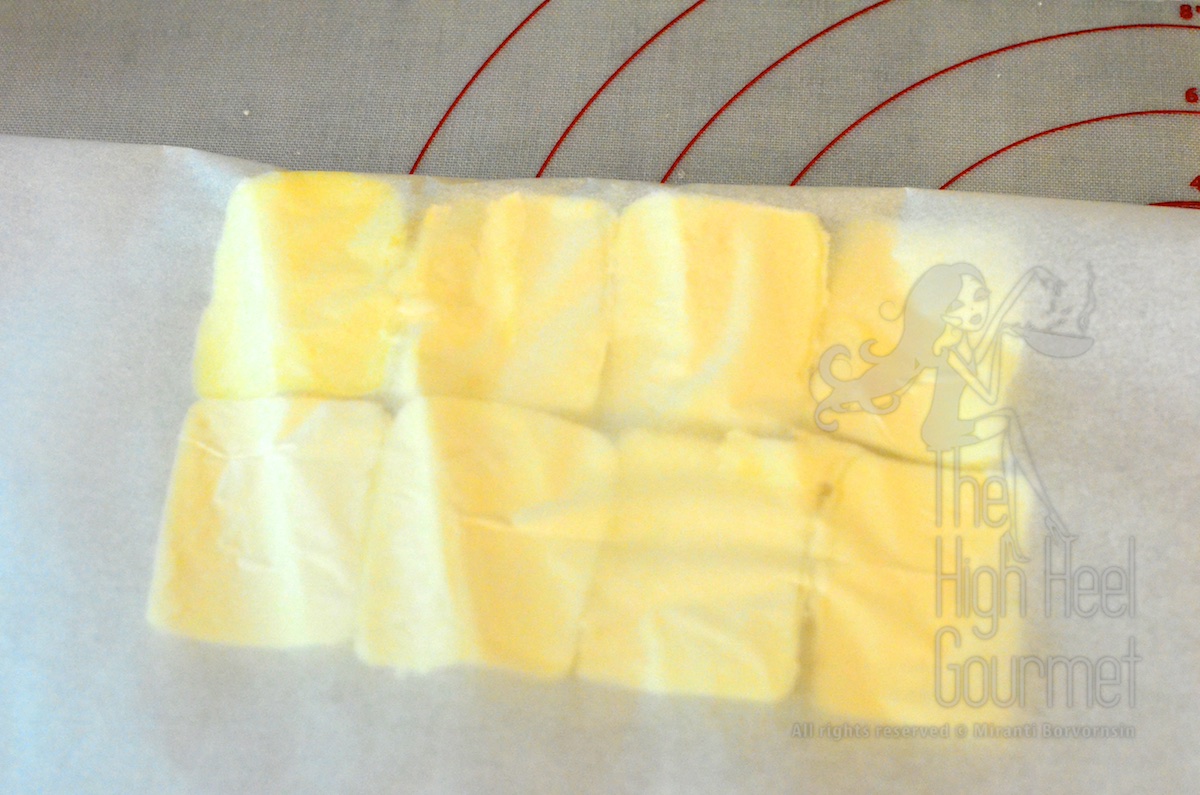
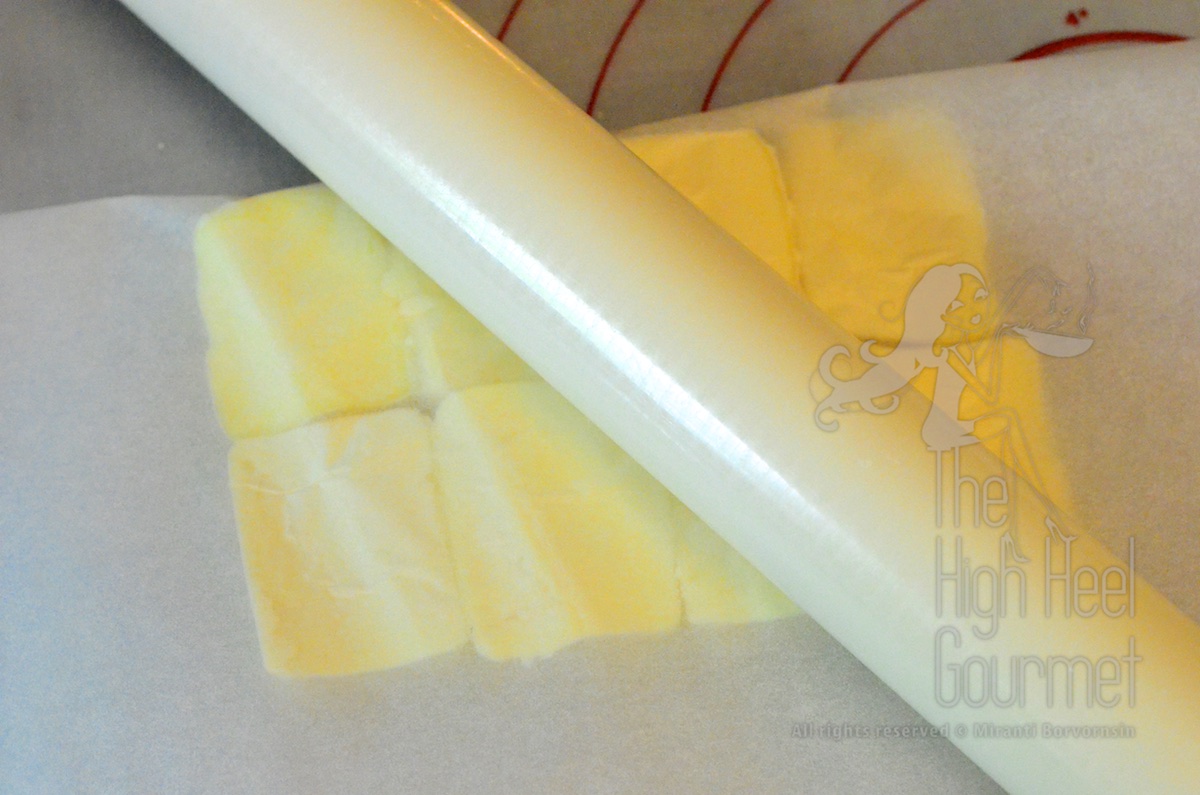
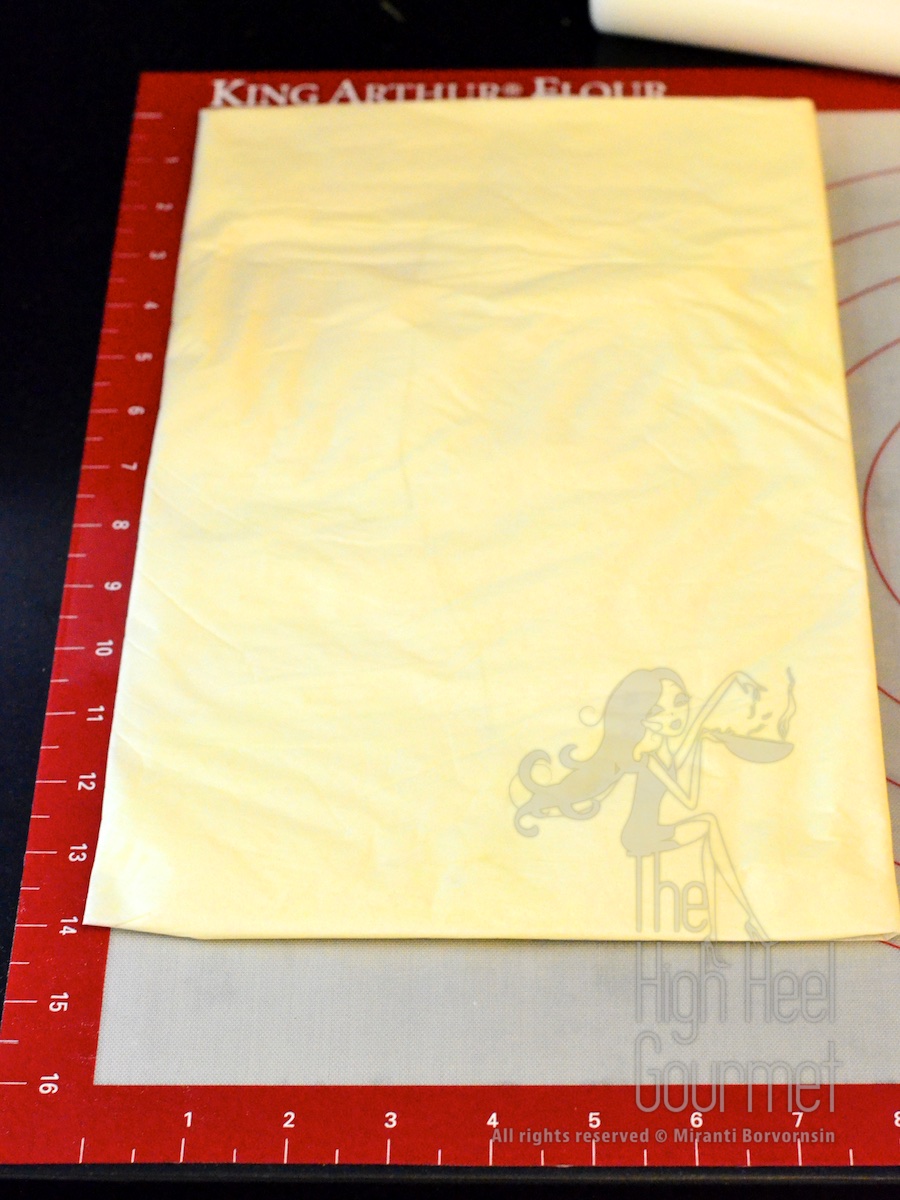
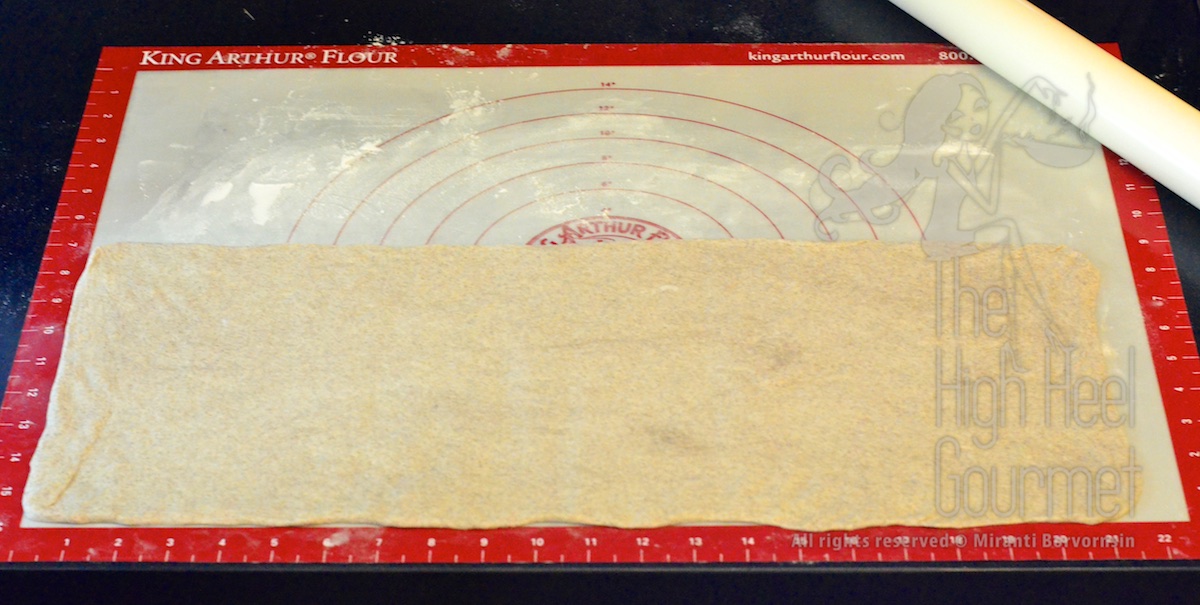
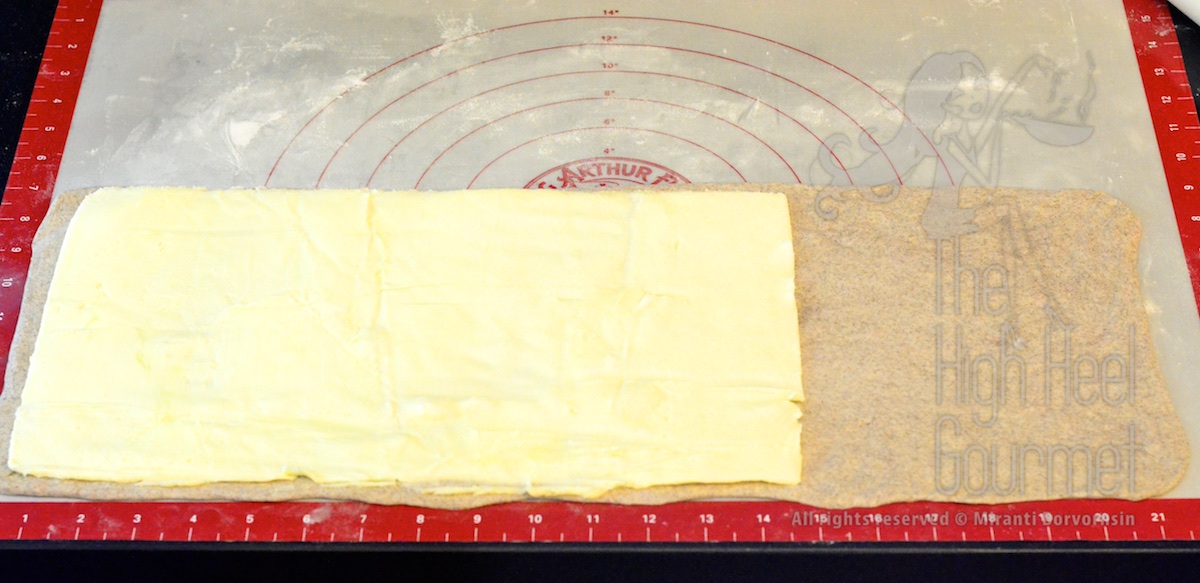
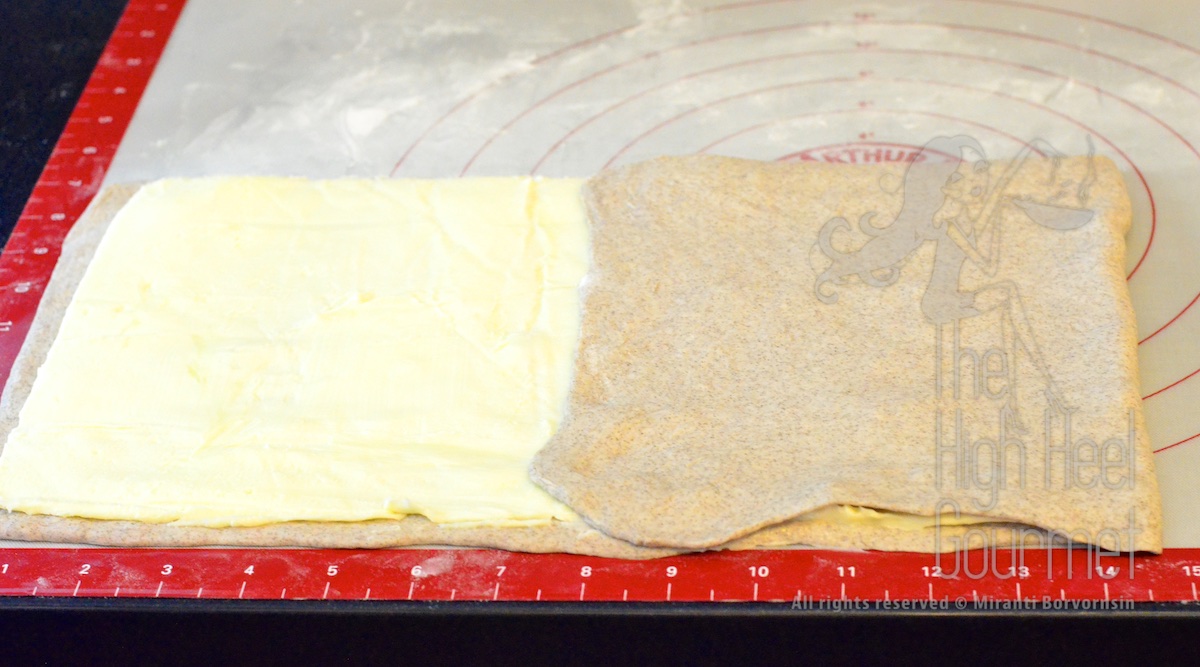
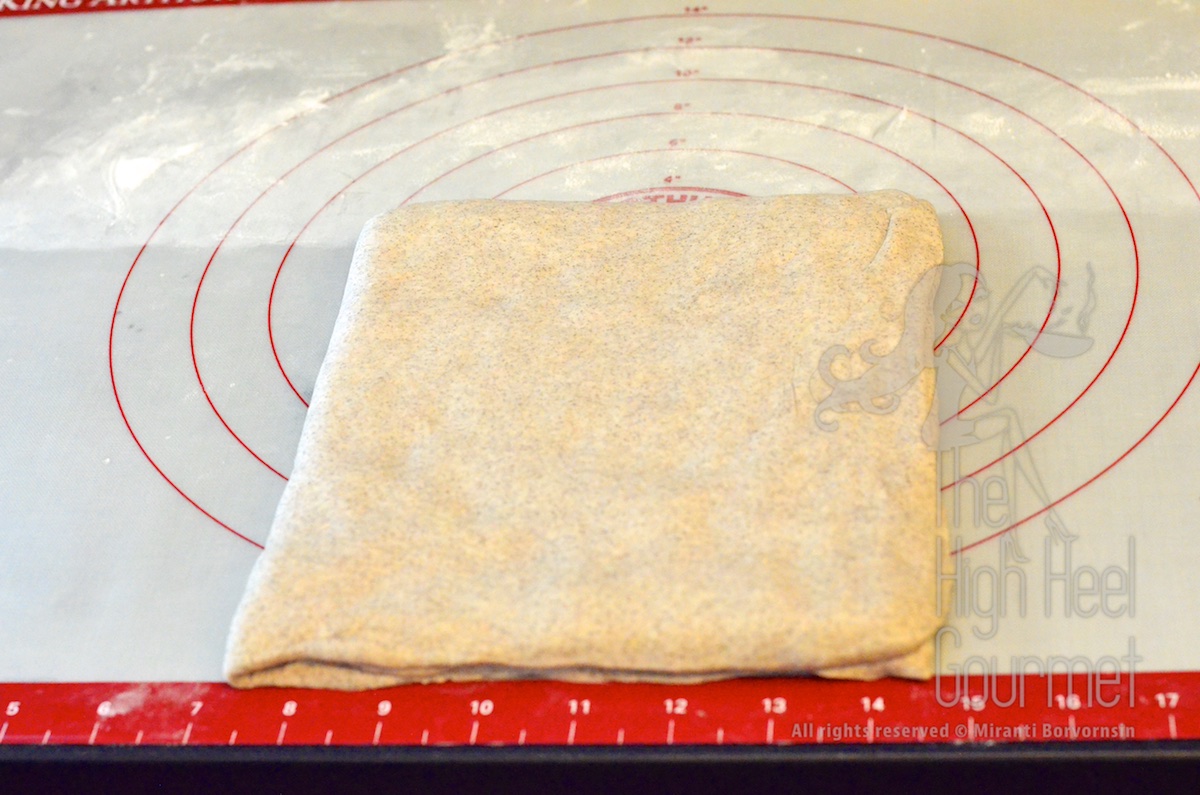
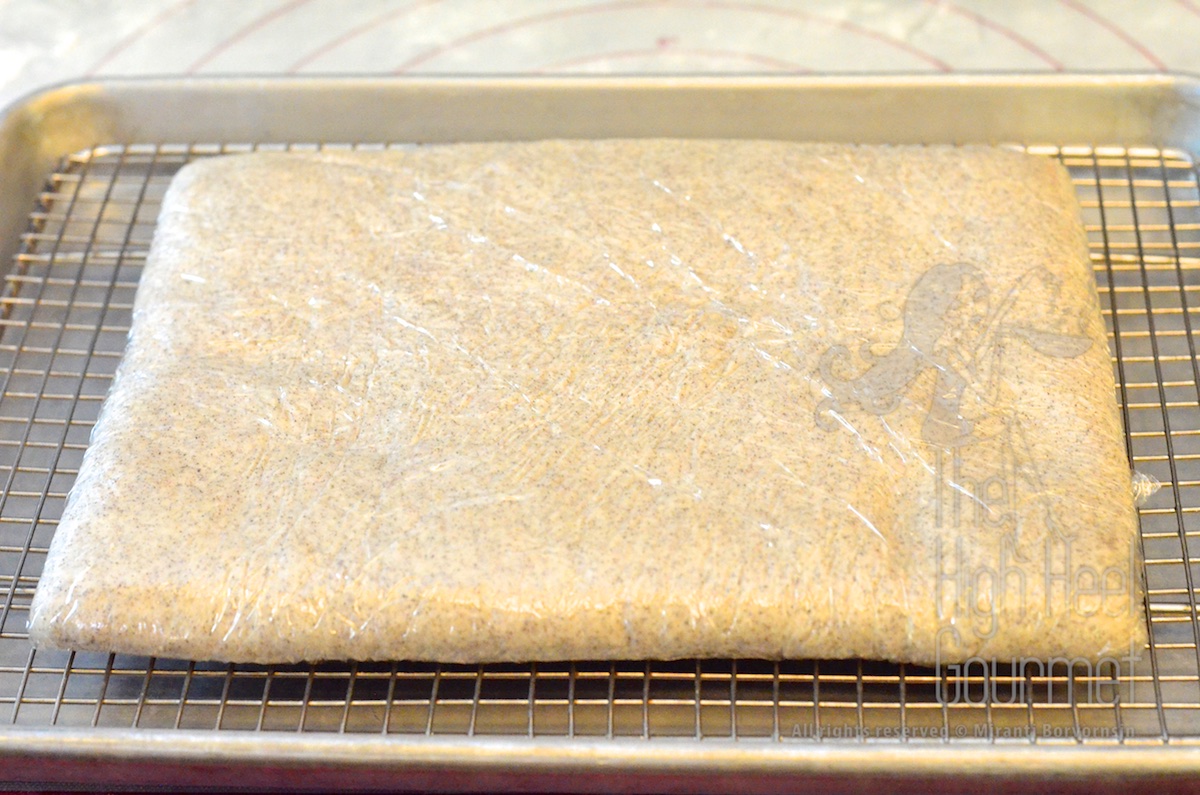
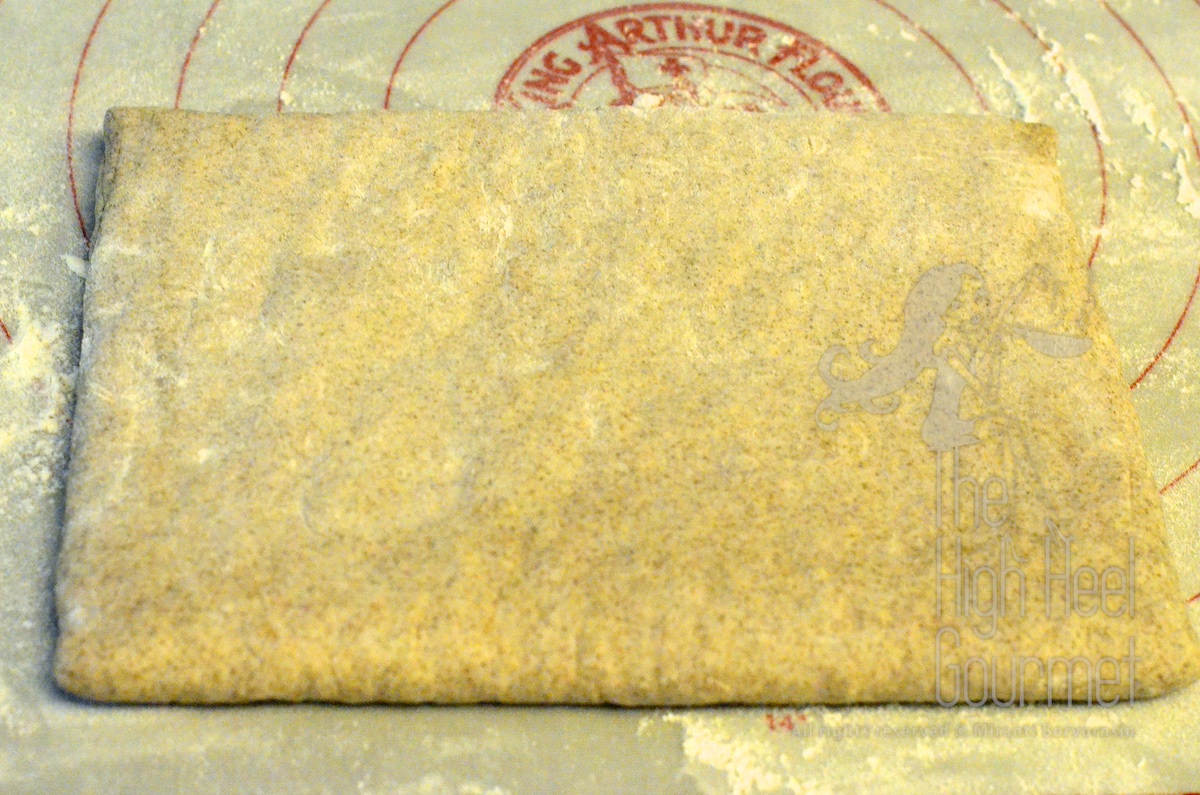
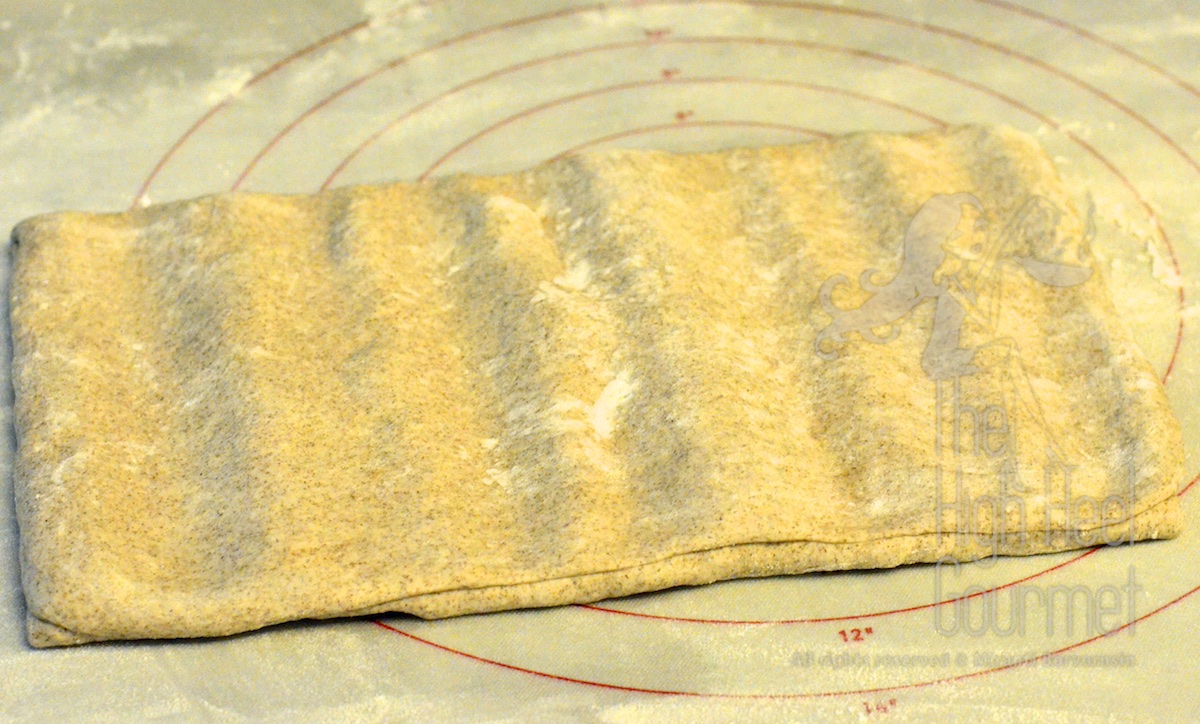
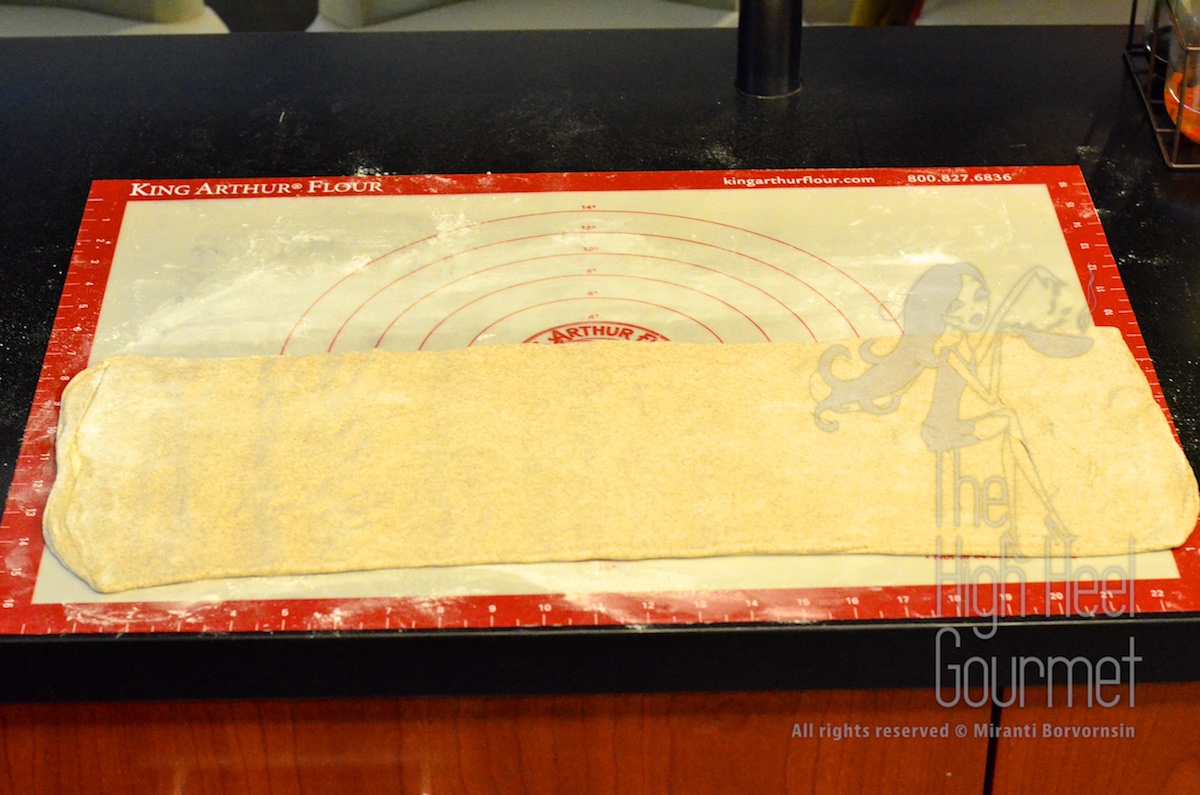
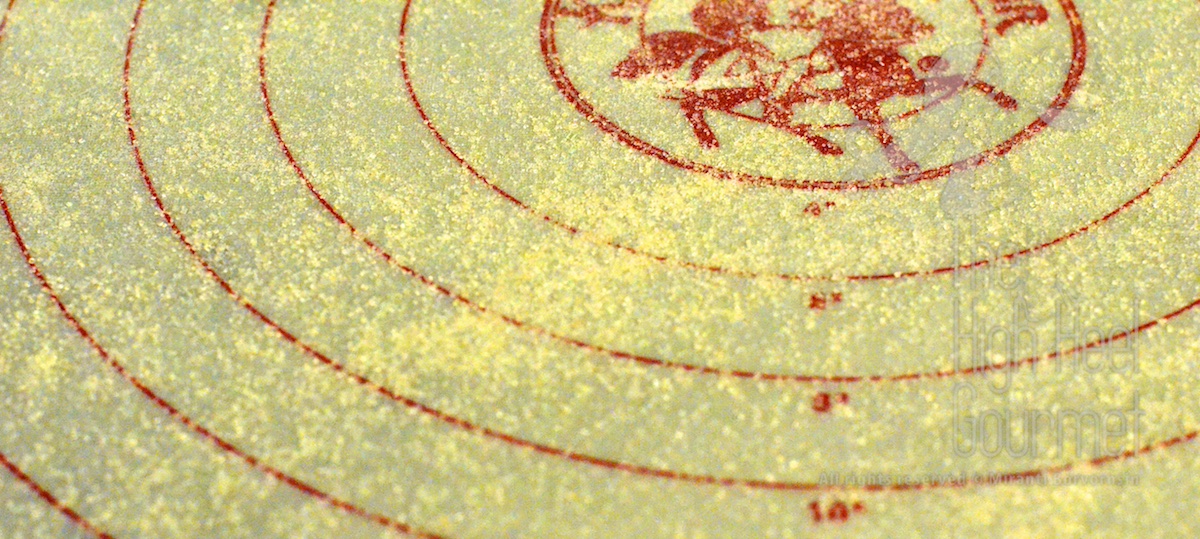
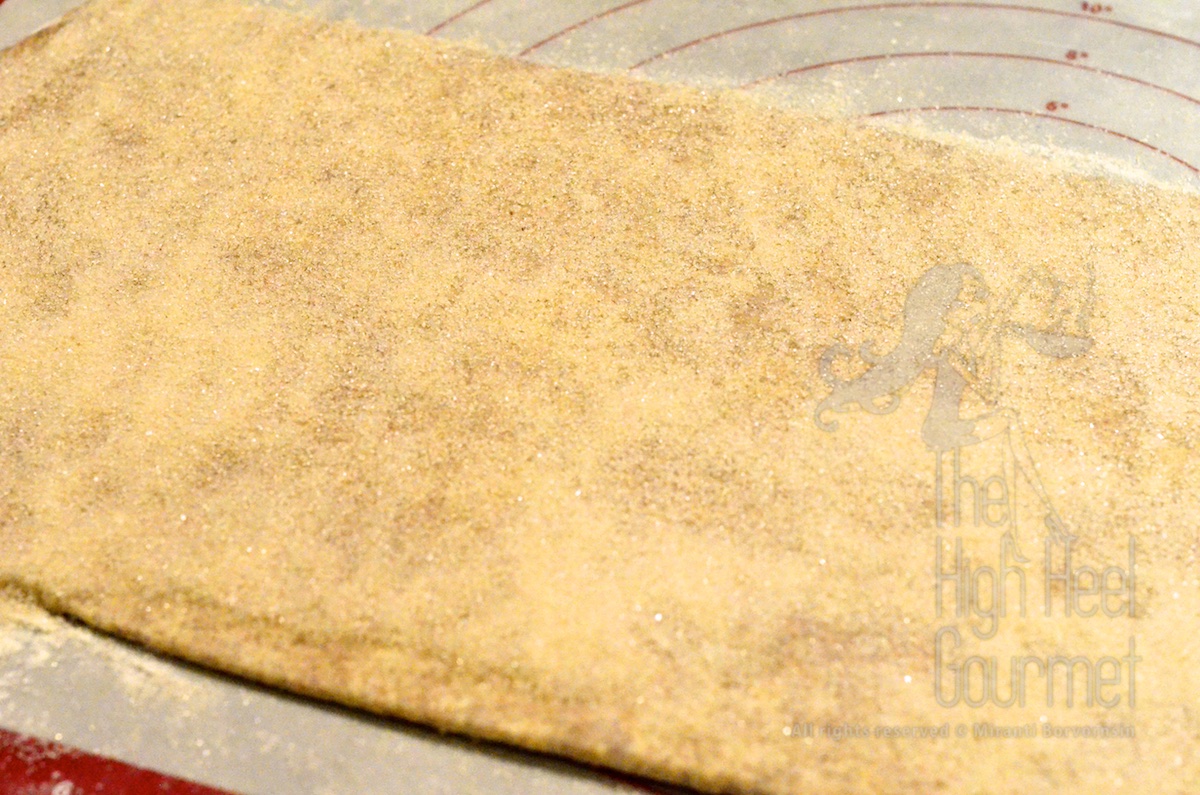
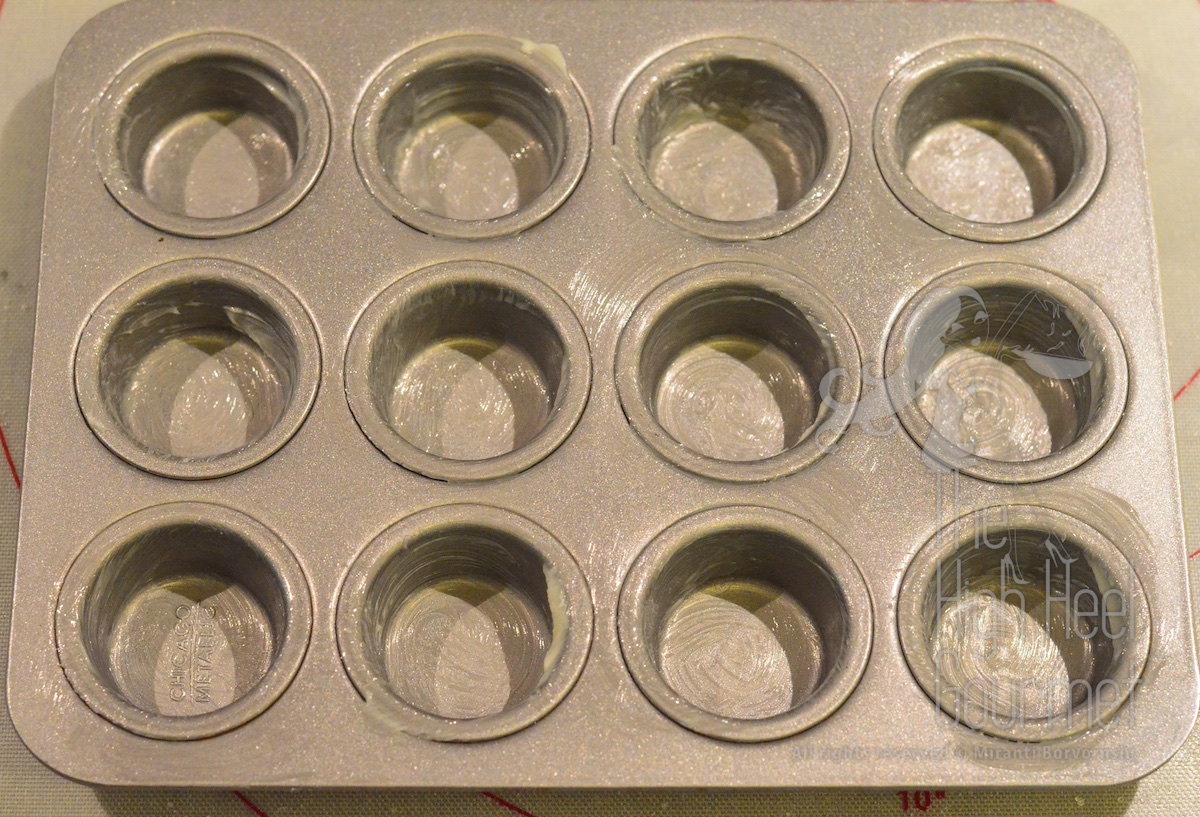
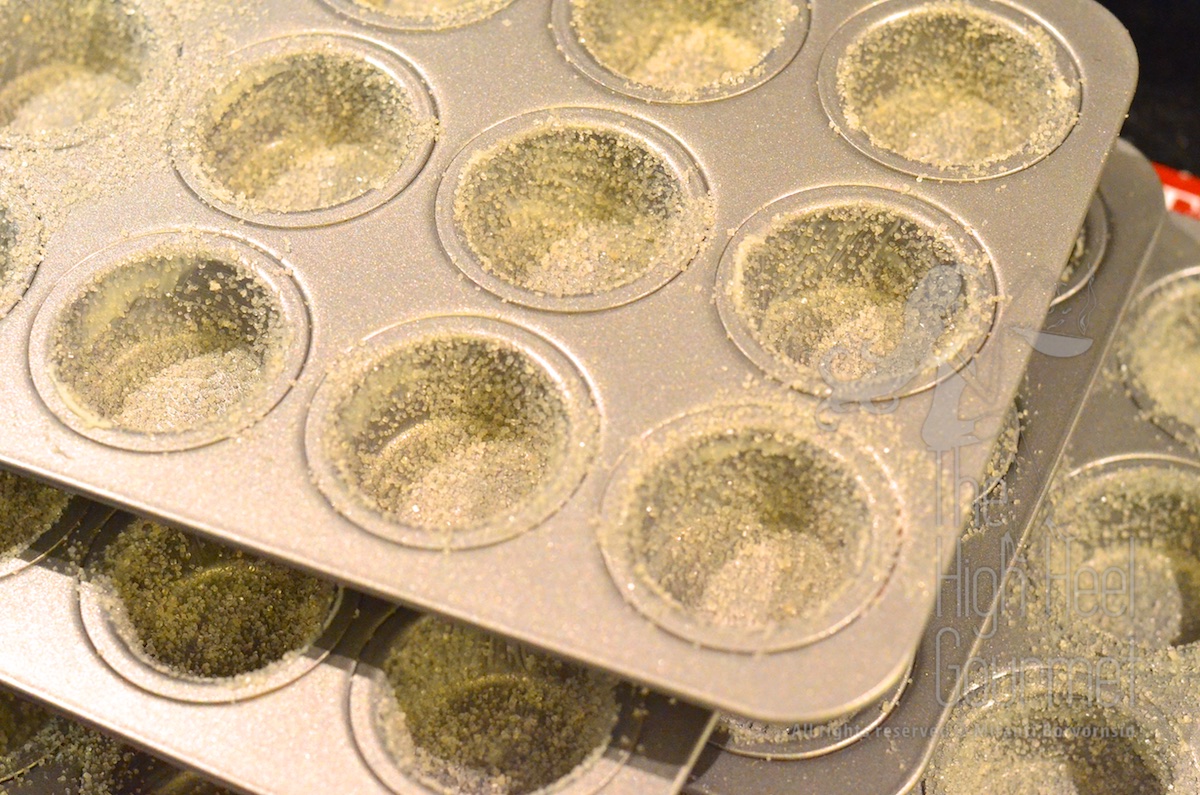
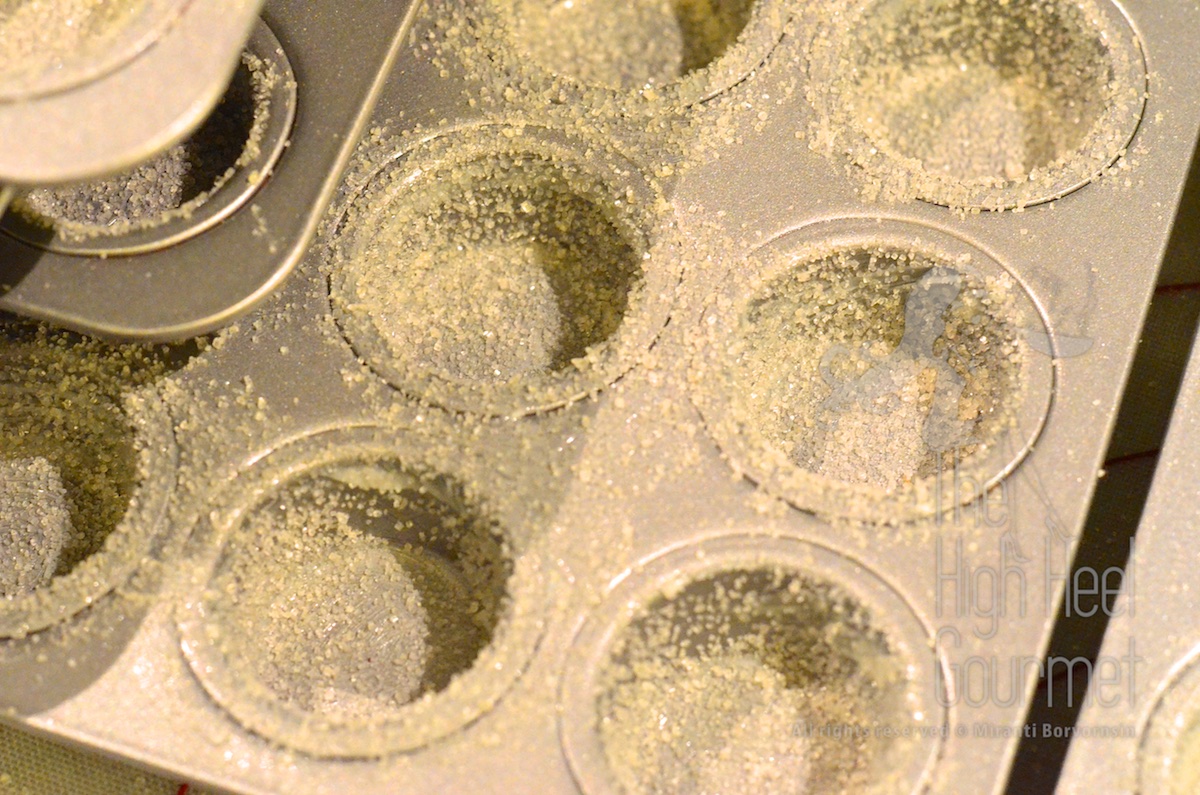
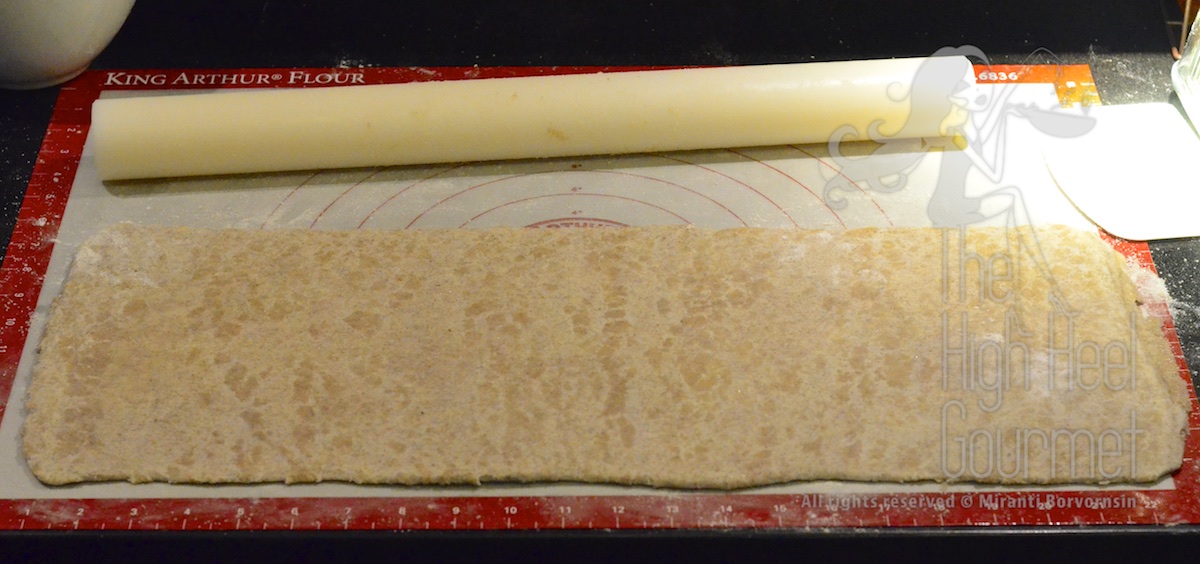
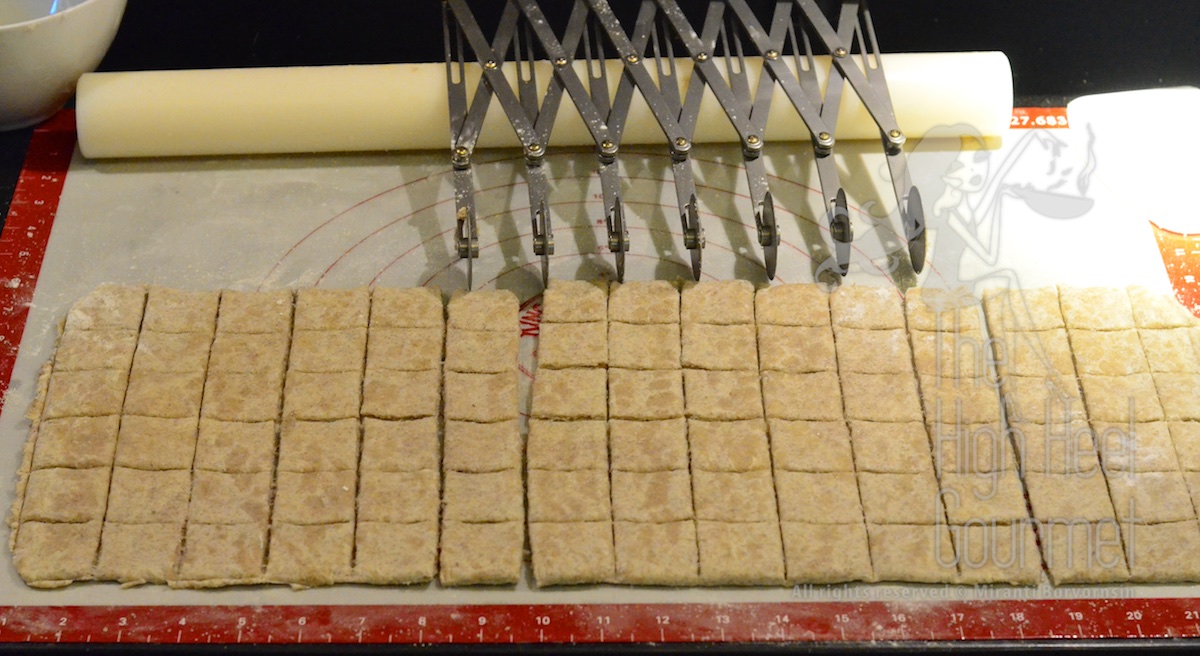
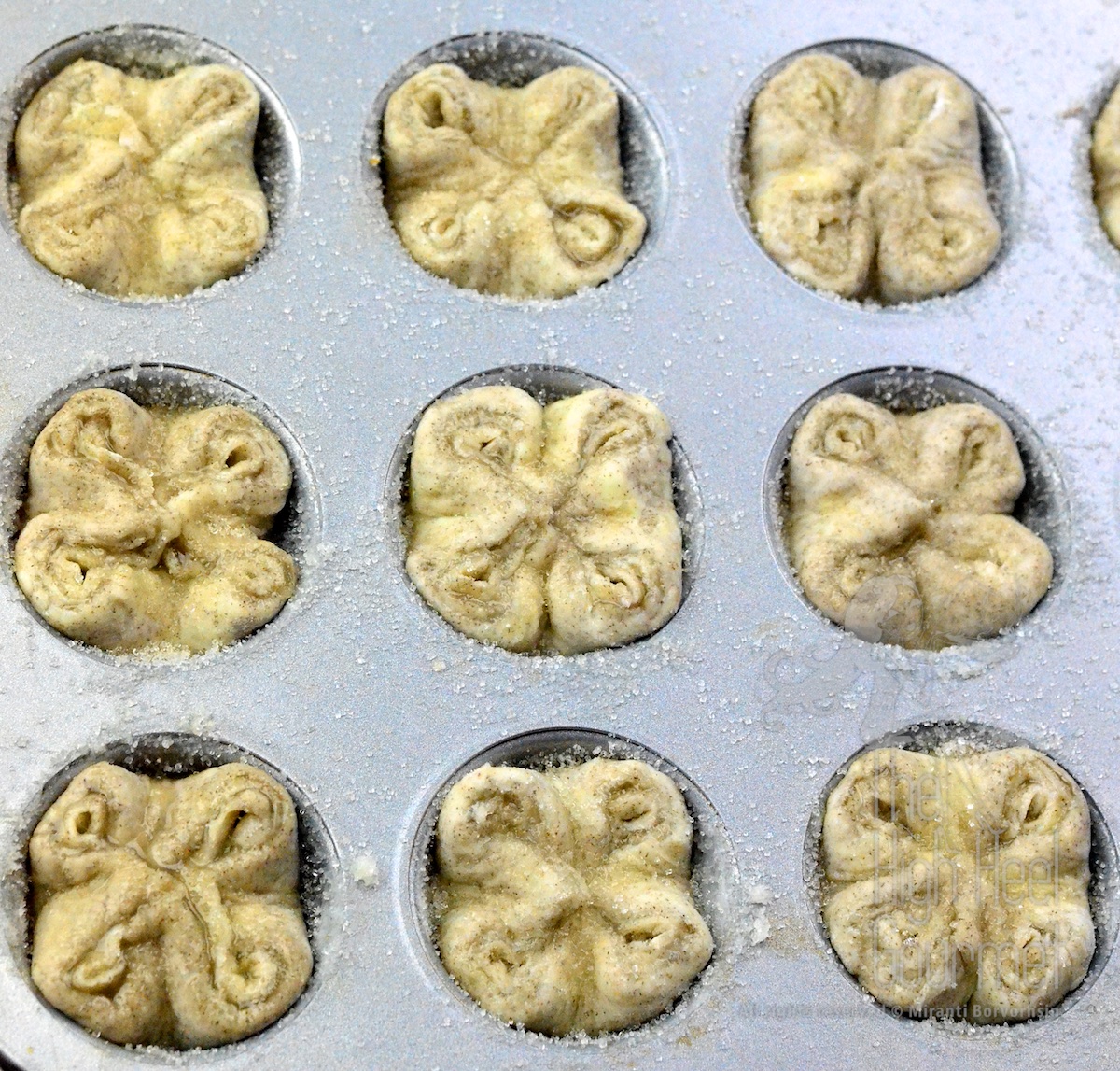
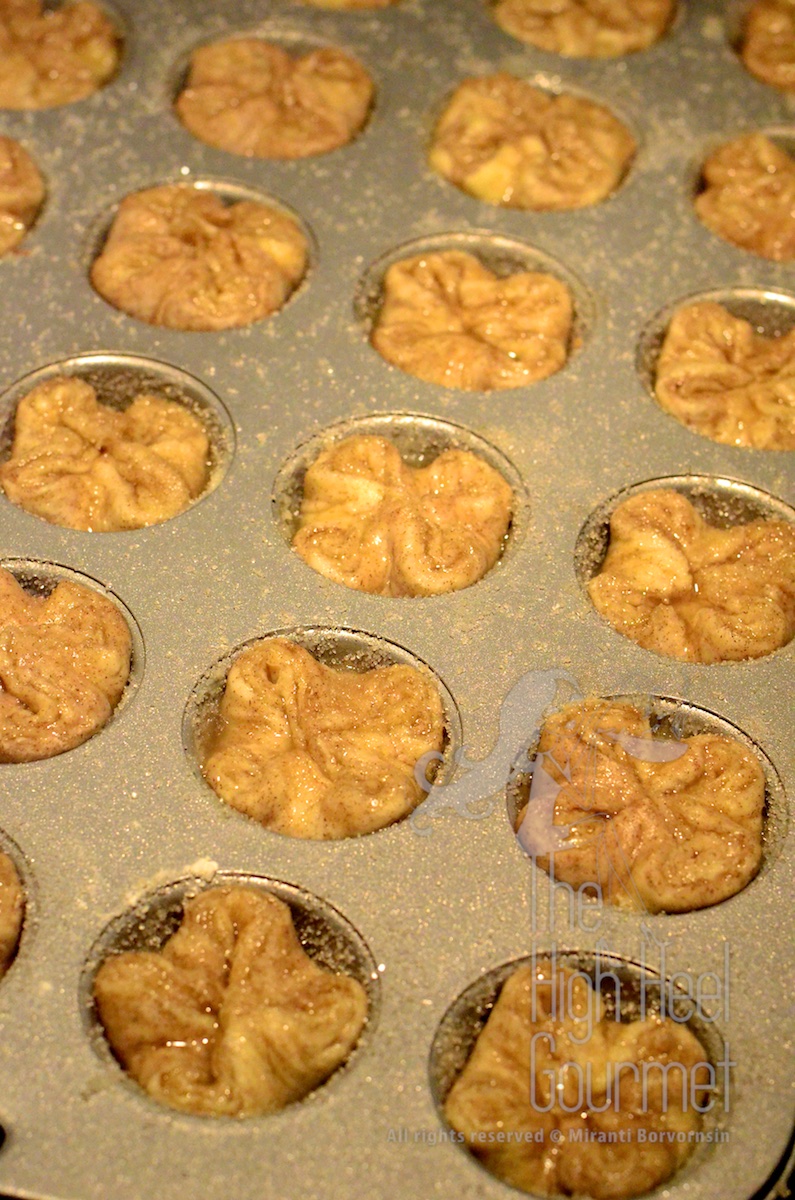
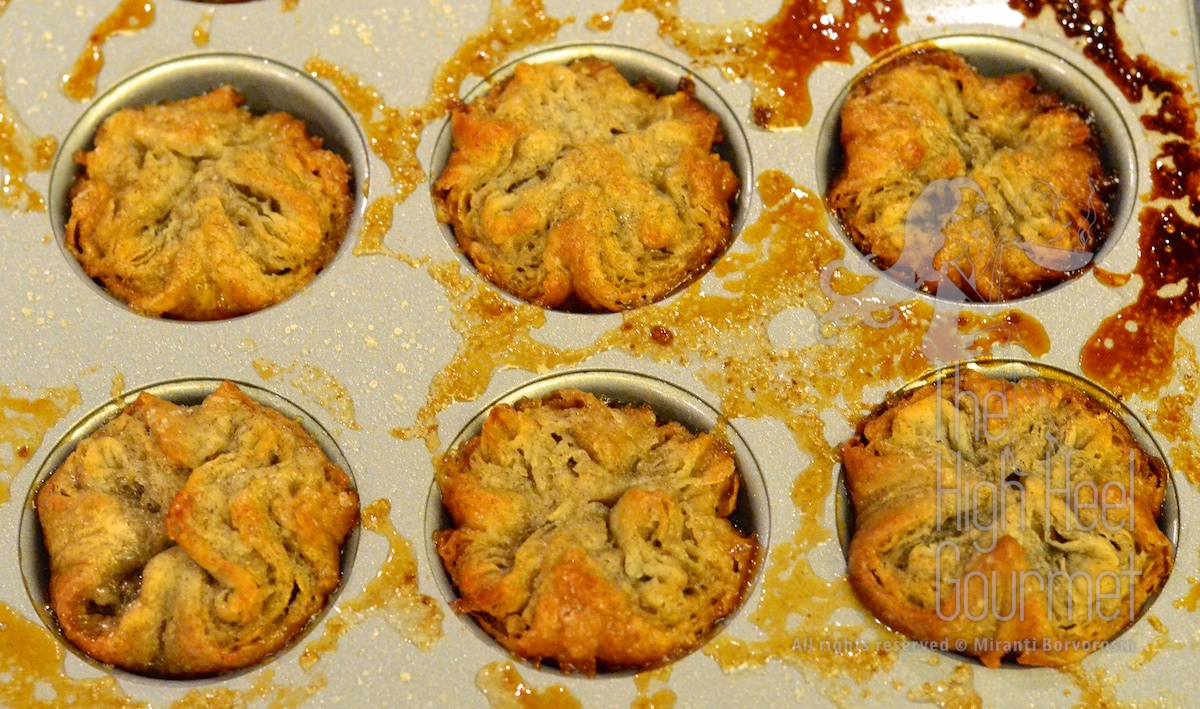
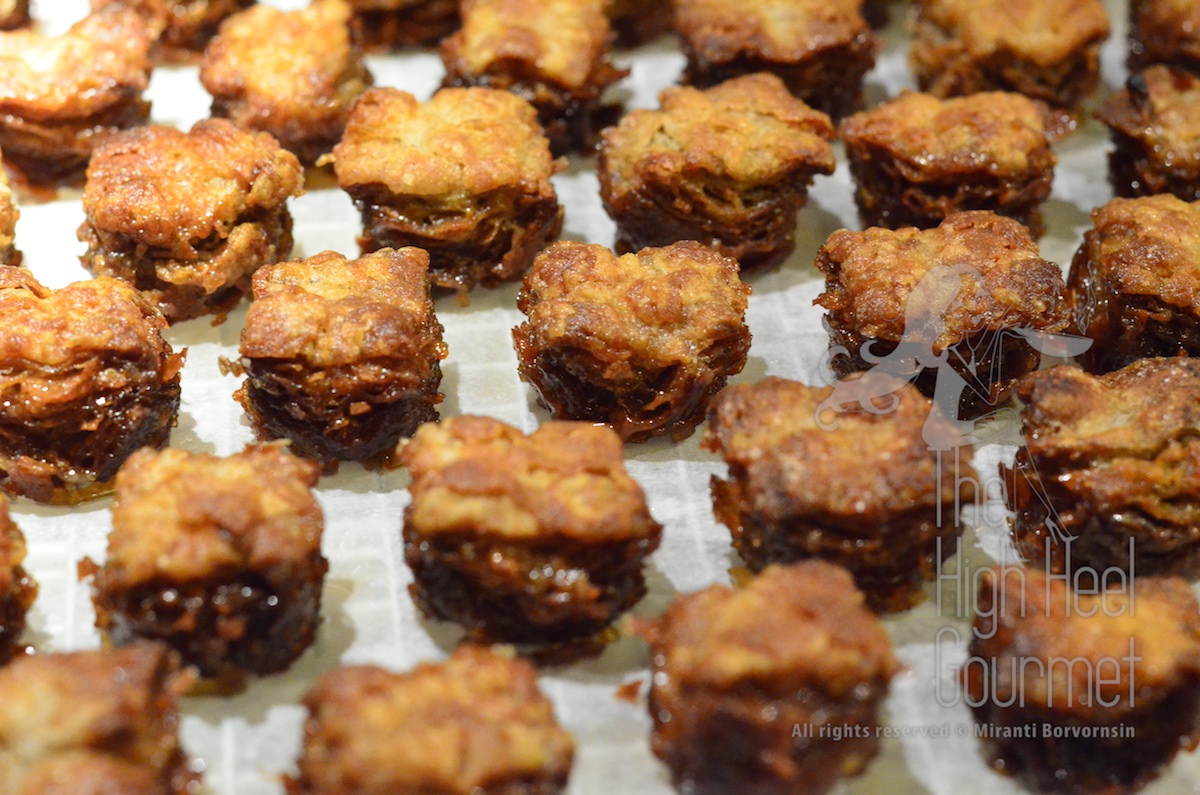
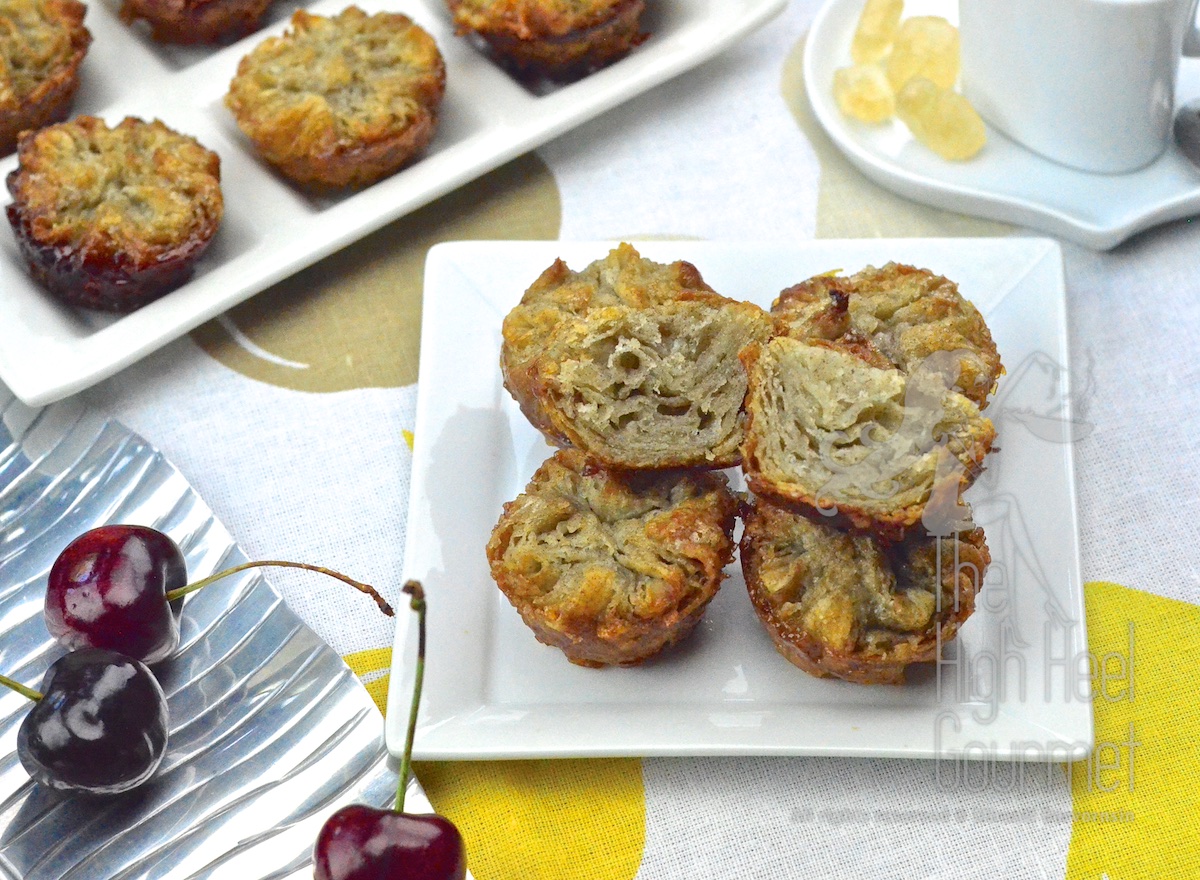
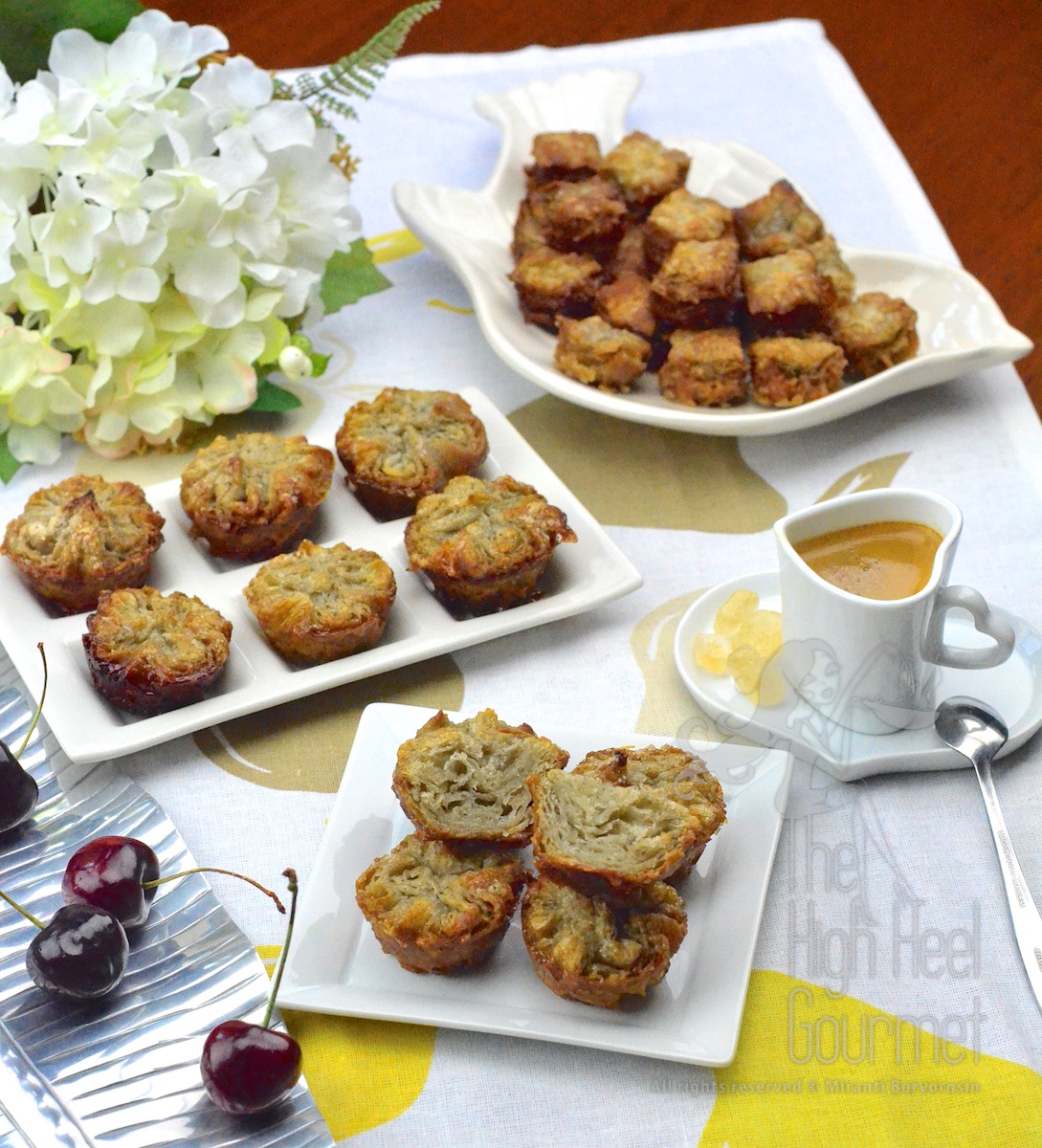
My husband’s (he is half Breton) favorite dessert 🙂 Happy you mentioned Kouign-Amann is from Brittany. As you probably know, the name is Breton, which is a Celtic language –that explains why it looks and sounds weird.
I’m so glad you made the comment. I wasn’t sure if the Breton language is French. I even look up the language (obviously can’t read it). So it’s Celtic language. Mostly from what I’ve seen, it was quite unpronounceable to me 🙁
I LOVE so many things of Breton, the crepe is one. The best crepe ever in the world. (My French girlfriend said I just like buckwheat but that’s not true)
Hi 🙂
Yes, it is Celtic. Not many people speak it any more but for example the town names are in both languages in Brittany.
Have you been there?? We usually go about three times a year, mainly to Cancale if it is just a short weekend. It is only 4 hrs from Paris and this is where the Romans came to eat oysters.
I love galettes (the salty crepes) too and my favorite is with leek and scallop. Have you had it? Out of this world, so delicious!!!
Brittany to me is one of the most distinctive regions of France. They have their own music, dances, food, etc etc, and people are quite down to earth (not “too much”). Many famous businessmen in France come from that region too! Stubborn people 😉
PS If you have some interesting buckwheat recipes, pls share! I like it but find hard to cook with it (especially if I don’t add anything that has gluten in it).
Interesting and new recipe for me. I have bookmarked it. Thank you for sharing it, Miranti!
G’day and wow what a recipe and thanks for allowing me to learn something new today too!
Sharing…Cheers! Joanne
Oh this looks so good!
Your Thai version is more fun to read.
Miss you.
อ๊ายยยยย…คี้ คิดถึงแกจังเลย กันยานี้เจอกัน ชั้นกลับไปงานแต่งงานน้องตอนต้นๆเดือนนะ
My goodness this looks delish~ I love this post and your blog. It is interesting, well written and it never fails to make me hungry. I have nominated you for the One Lovely blog awards and I truly hope that you will accept the award. Here are the rules: http://alexisfashiona.com/2014/08/10/fashion-a-now-a-one-lovely-blog/
Yours truly,
Alexis
Actually when I wrote my book about vegetable carving this gourmet helps me to think.
lol…is your book coming out yet? I am interested. If so please, send me a link or the publish date.
Hello I just discovered your blog and this fantastic-looking recipe. Question: do you think one could make and freeze the dough after, say, step 15? I’d love to serve these for company but they look a wee bit time-consuming!
This is not just pastry dough, there are yeast too. I’m afraid that if you freeze for too long the yeast will die and you won’t get a fluff kouign-amann but the dried stagnant one. I never freeze them before but if I guess, I will freeze after baking and defrost when I’m ready to serve.
Yeah, makes sense. Maybe I’ll try an experiment and make them but save a few to freeze. These look amazing. Thanks for the fantastic step-by-step.
🙂 I’m glad you can use this.
Freezing will not kill yeast.
The English instruction part is so detailed! But Thai part is just fun to read! 🙂
My ex is from Bretagne and kept talking about this all the time back then but i dont have enough patient to put my hands on it until i recently have a bite for the first time. Heaven’s in my mouth!
What?! You can read Thai too. 🤣😂 It’s really one of my favorite guilt. If you can’t find a place that make it real good, you have to do it yourself.